Maja Voje's Blog, page 7
October 4, 2024
Win on Product Hunt: A Step-by-Step Action Plan
In this Substack, you will learn:
What goals and benchmarks should you set up
Action plan for your Product Hunt Launch Day
How Videco reached #1 PoD and an investment opportunity with +840 upvotes and +360 comments (and still growing)
And some rants by yours truly 🤠 about how you can simply buy this badge
Up for a kitty hunting adventure? 😼
Dear GTM Strategist!
Like it or not, the “Product Hunt” badge is still a conversion booster.

I get lots of requests for support Product Hunt launches on LinkedIn, so I admit—I am sometimes numb to cold outbound requests on LinkedIn to support random launches of “game-changing products” just because I like tech and to support startups.
I have seen teams that I mentored through accelerators and VC preparing for months to win the #1 Product badge only to see sad retention and monetization post-launch stats. Honestly, I think PH has seen better days, and I prefer to coach my portfolio companies not to bet everything on their PH launches in most cases.
But I know that PH badge helped some of my teams be taken more seriously by VCs and journalists, and to be brutally honest - you can buy your way in without too much effort if you are just doing it for the badge. You build or hire an engagement pod - warm-up profiles to vote for you, pay a mega-hunter to feature you on their newsletter or spam the s*** out of your LinkedIn network and something will stick. I know a team who got it for $200, but let’s talk about gray hat techniques some other times …
Some entrepreneurs in my network have incredible examples of successful PH launches with tangible business results and excellent learnings. You can apply their learnings for either PH or “normal” launches.
I invited Alexandre Contador, CEO & co-founder of Videco.io to tell his very recent story of how to win on Product Hunt in 2024, with a positive ROI on the efforts and resources you invest there.
I am handing over the pen 🖊️to a Product Hunt hero now.
How to reach #1 Product of the Day on Product Hunt? (+realistic results)by Alexandre Contador, CEO & Cofounder, Videco.io
Launching on Product Hunt is more than just a competition—it’s a chance to showcase what you’ve been working tirelessly on for months. It’s also an opportunity to refresh your brand and get your product noticed by a global audience.
When we decided to launch on Product Hunt, we knew our product wasn’t fully mature yet. In fact, we made a bold decision to completely pivot our core features with only one month left before launch (crazy, I know). Initially, we envisioned our product as an interactive video platform aimed at marketing professionals, but the market was already saturated with similar solutions—many of them overpriced.
So, we shifted gears. We transformed Videco into an AI-powered personalized video platform specifically designed for BDRs (Business Development Representatives) and sales professionals who want to hit their quotas through creative video outreach campaigns. The market was craving something different, and we had the answer.
 Videco’s website - https://videco.io
Videco’s website - https://videco.io Despite feeling underprepared and facing significant pressure, we decided to go for it. Let’s be honest—our product is still far from perfect and doesn't fully align with the vision my co-founder and I have for it yet. But we’re driven by our goal to become the best video prospecting platform globally, and we’re committed to making sure our customers are thrilled with their results.
But enough about our story—let’s dive into the exciting world of Product Hunt and how you can aim for the coveted title of #1 Product of the Day.
Why Strive for Product of the Day (and Beyond)?So, why should you aim for Product of the Day, Week, or even Month on Product Hunt? It’s simple: that badge on your website is more than just a status symbol. It’s a public acknowledgment that, for a moment in time, your product stood out among a sea of other startups, including companies backed by Y Combinator, venture-funded giants, and long-established brands.
For a solopreneur or a small team, this visibility is priceless. It’s the kind of exposure that can change everything.
Reaching it requires a couple of steps. Let's dig in:Step 1: Prepare in advanceLike everything else in life, preparation is key. You need to be ready and assemble a task force that can help drive your campaign throughout the week. Start by creating standard templates for copy that you’ll use in various situations, including follow-ups. This will save you mental energy and keep you focused.
Next, gather a list of leads or community members who can help give you that initial boost during the first critical four hours. I recommend having at least 1,000 profiles on hand to reach out to.
Additionally, make sure to craft a compelling copy for your product page, your pitch, and a set of community discussion posts. I suggest posting three times per week on Product Hunt before the launch and three times on the day of the launch.
Step 2: Engage heavily in the PH community (PH, Facebook, LinkedIn, WhatsApp)To succeed, you need to be actively engaged in various Product Hunt-related communities—whether it’s on Product Hunt itself, Facebook groups, LinkedIn, or WhatsApp. Supporting others in these communities is crucial, as it builds goodwill and increases the likelihood that they will support you in return.
The philosophy of "give and you shall receive" worked wonders for us. It helped keep us in 1st place from the start of the day until the very end. So don’t underestimate the power of community engagement!
 Launch day metrics from Product HuntStep 3: Find a good hunter
Launch day metrics from Product HuntStep 3: Find a good hunterA "hunter" is anyone who posts a product in Product Hunt. A maker is anyone who has a part in creating the product. You can be both hunter and maker or someone else can also hunt your product. In general, makers try to find a hunter with a big audience so the product gets seen on top of their feed.
Finding a good hunter is crucial to your Product Hunt success. There are several places to connect with experienced hunters, but keep in mind that their inboxes fill up fast. Start reaching out to them as early as possible to ensure you secure the right person for your launch.
Step 4: Optimize your profile and product pageMake sure your Product Hunt profile and product page are fully optimized. Follow Product Hunt's guidelines by adding a video demo, high-quality images in the correct sizes, and a well-structured copy that clearly communicates your product's value. The more polished and professional your page looks, the better the chances of attracting attention.
 Videco’s profile on Product Hunt (https://www.producthunt.com/products/videco-ai-personalized-video)Step 5: Launch your teaser page
Videco’s profile on Product Hunt (https://www.producthunt.com/products/videco-ai-personalized-video)Step 5: Launch your teaser page Creating a teaser page is an effective way to start building anticipation for your launch. It allows you to promote your upcoming product, engage with key profiles and communities, and generate buzz before the big day. A strong pre-launch campaign can make all the difference, so use the maximum amount of time before it.
 Alexandre’s pre-launch post on LinkedInQuick Action Plan for Your Product Hunt Launch Day
Alexandre’s pre-launch post on LinkedInQuick Action Plan for Your Product Hunt Launch DayLaunch at 9 AM CET Sharp
Product Hunt launches start at 9 AM CET, so have your social media images and posts ready to go live at that exact time. Don’t wait—the first 4 hours are crucial for gaining traction.
Check If You’re Featured
Review the Product Hunt homepage to see if you’re featured. If you’re not, don’t panic—it’s not the end. Keep pushing hard for that top spot through consistent engagement.
Send Subscriber Emails
Launch emails to your subscriber list at four different times, spaced 4 hours apart. This staggered approach ensures your message reaches people at different times and keeps momentum going throughout the day.
Engage with Comments Immediately
If you start getting comments, respond right away. Your entire team should be focused on community engagement, especially during those critical first 4 hours. Prompt responses build relationships and keep the conversation active.
Ask Questions and Build Connections
When engaging with the community, don’t just respond—ask questions back. This helps create a connection and encourages further interaction, which is key to gaining visibility.
Post Across All Communities
Publish updates in all relevant groups and communities to maximize exposure. Make sure you reach out to your network and leads list to gather early support.
Monitor Product Performance
Keep an eye on your product’s performance and ensure everything is working smoothly. We use PostHog to track sign-ups and user activity, and it’s been a great tool for monitoring real-time engagement.
Schedule Posts for Different Time Zones
If your audience spans multiple time zones, schedule additional posts throughout the day to maintain visibility and engagement as the day progresses.
Take Breaks
It’s going to be a long day, so rest when needed. You’ll need your energy to stay focused and responsive as the day unfolds.
Celebrate and Share Your Victory
Once you’ve earned that Top Product of the Day badge, don’t forget to share it! It’s a great way to boost morale and keep your product in front of people on social media and beyond.
 Celebration post 🎉Here are some results from our own experience:
Celebration post 🎉Here are some results from our own experience:

Reached #1 PoD with +840 upvotes and +360 comments, and still growing:
+300 visits to our website, and +100 signed up for a free trial (we don't have a free version)
+250 visits following day, and recurring
A lot of positive feedback and also some more harsh ones but needed :)
+80 possible opportunities/SQLs
Invited to speak at 2 podcasts and 1 event
1 pre-seed investor
Regions: US, Brazil, Argentina, Portugal, Spain, BLX, and more.
 Positive feedback from the “hunters”Post-Launch Reflections
Positive feedback from the “hunters”Post-Launch ReflectionsProduct Hunt is an interesting marketplace for products looking to test the waters and get feedback from an active audience. But don’t take it too seriously—it’s not the end of the world if you don’t get enough upvotes. Failing to hit the top rankings doesn’t mean your company is doomed. This is simply a competition, and it’s perfectly fine not to be among the top 5 products.
In fact, we noticed that several excellent products ranked below us, even though they deserved higher spots. So, don’t view Product Hunt as a make-or-break situation for your business.
One thing we learned is that Product Hunt also has its share of opportunists. Some individuals or groups try to exploit founders by creating upvote farms, threatening to report your product if you don’t comply with their demands. If you encounter something like this, it’s important to be cautious and reach out to Product Hunt support for help.
Aside from that, as long as you prepare well and stay focused on your goals, Product Hunt can be a valuable experience for your product launch.
My sincere congratulations to Alexandre and his team.
He really made me rethink my relatively cynical attitude towards Product Hunt and I am so happy to see this team build and win in public 🏆
Product Hunt, yes or no - it is your choice.
But remember, there is no time or money to waste in Q4.
Either go all in and be in it to win it … or don’t do it and focus these effrts to some other GTM tactic that will produce better results for you.
So - are you in or are you out?
Happy hunting - on Product Hunt or wherever your target audience may be.
 Are you ready to dive deeper and work on your Go-To-Market strategy and execution?
Are you ready to dive deeper and work on your Go-To-Market strategy and execution?Discover my solutions that support your journey from launching to scaling:
🛰️ Explorer: Understand Go-To-Market and develop a winning GTM plan.
Get best selling GTM Strategist book + 20 frameworks (workshops) + online course ($47). Tested by 6500+ companies
🚀 Doer: Leverage the 100-step GTM Checklist tested on 650+ launches with templates (emails, launch plans, posts, landing pages), which will guide you from getting ready to launch to an impactful launch and scaling stage.
Get the Checklist ($97)
💫 Leader: Guide your team to successfully choose ICP (target market), pricing, positioning & selection of best GTM Motion (channels, tactics). GTM Bootcamp includes 5 hours of applicable videos and a personal Miro board.
Get the Bootcamp ($347)
[BESTSELLER] 🏆 Ready to win: Tackle the most pressing Go-to-Market issues such as selection of ICP, positioning, how to get customers, build teams and select proven ways how to go to market. Book a 90-minute hands-on consultation with Maja, get personalized guidance, a Miro board, and reliable vendor contacts for further work.
Want to bullet-proof your 2025 strategy? Book a session ($500)
September 27, 2024
5 lessons learned from launching my GTM Bootcamp
In this Substack, you will get tactical ideas to apply to your launches. We will dive deep into:
How to create good offers
Create credible social proof
The power of authenticity
How to leverage influencers for your launch
How to create landing pages that convert at 7-9%
Dear GTM Strategist!
We did it! 🎉 After only three days, I am happy to report that the GTM Bootcamp launch reached its targets. I knew that the product was damn good - but you know how it is. You never know for sure. The market “always tells.”
Thank you so much for your stellar support and for sharing your enthusiasm for the launch with me.
I am sharing lessons learned from this launch so you can apply them to your Q4 launches and beyond.
1. Hot offer for the win ♨️By now, you know that I am unapologetically a fan of entrepreneur Alex Hormozi whom some of my more intellectual friends call the lumberjack philosopher 🤠. Still, I love his stuff because it is clear and easy to implement. My favorite “Mozi formula” is this one:

And that is precisely the formula I followed when I created my landing page and packages.
While most industry experts do cohorts, I was like - dang, people across time zones do not have the time to tune in at midnight. I feel terrible whenever someone tells me that they need to spend time with their kids in the afternoon - not on Zoom calls.
Moreover, many potential candidates are justifiably concerned that spilling their business secrets in front of 50 strangers on Zoom might not be the best idea especially when you build in a stealth mode and 4 people in the group might be your competitors.
 The offer on https://gtmstrategist.com/bootcamp/
The offer on https://gtmstrategist.com/bootcamp/So I resisted the pressure and said: “You can DIY this - you are smart enough to do it. But if you are dealing with a more complex business case and need more guidance, I will be there for you to make sure we crack the mission-critical challenge personally”.
I know the completion rates:
Udemy courses: 3-5%
Cohorts: 70% show up
If we do it together: 100% show up
We will get the job done.
Otherwise - we always have a safety mechanism of a money-back guarantee.
While I am not saying that it is a no-brainer offer, it’s the best offer I have up to date. The previous version of the product was selling for $1500 “done with you” and $997 as a cohort.
2. Double down on RELATABLE social proofIn retrospect, I think that I am making a mistake by pushing “big logos” of my references to the frontline. I am not saying that you should hide them if you have them. If something is good enough for Google, Bayer, Heineken, Spar, Rocket Internet - it is probably OK, right?
But the relevant question here is - will it work for me - I am an “indie developer with a full-time data science job and I do cool shit aside”. For that, we need a different sort of evidence. Were there people similar to me able to implement this? Can we share real numbers, stories, and names across geographies?
I emailed past customers and asked them 2 questions:
What (value) did you get from [my product/service]?
Do you have a result (numbers) to share?
Yes, we can 💪
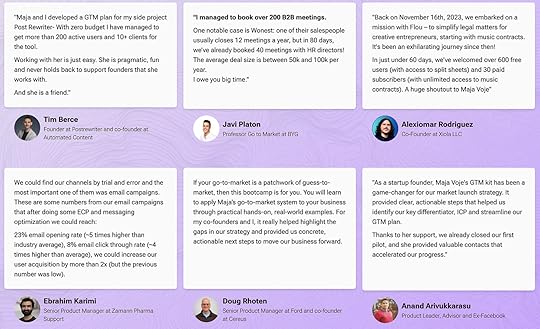 Meet the real GTM Strategist Heroes
Meet the real GTM Strategist HeroesI only wish that I would have done it sooner 🤯
Do you have a story to share? Send me your success story. I am happy to feature it on my Substack and landing page with a backlink. I want to hear from you. You are the real heroes.
Pitch in here: https://docs.google.com/forms/d/e/1FAIpQLSf-ao70gQM6QoYHdeJ7A-fRa3jfHSTw9V1v-QM8Zb_EUkCR-g/viewform
In fact, if you analyze the landing page, you will see that I use 4 layers of social proof:
My traction
Hero stories from entrepreneurs who applied the GTM Strategist methodology
Partners who use methodology
Total stats - numbers
In short: show, don’t tell.
You say it < Others say it.
3. Be there for your customersI spent 22 hours answering questions from the community about the GTM Strategist Bootcamp.
All conversations came down to 3 obstacles:
Price - “waiting for a paycheck, need to pay from company budget, do you offer installments?”
Time - “busy Q4, thinking of doing my consulting, will let you know when I decide, how long is the program - how much time to spare?”
Added value - “is it technical founders friendly, is it advanced enough for me, is the content the same as in the book, is it for scaleups too?”
I did everything I could to address them: Tella videos, calls, emails, voices. Each question deserves a good answer.
If I do not think that the program is the right fit for you, I will tell you.
We also gave all the buyers of the previous version of the bootcamp recordings a FREE upgrade to the new version. Why not? We appreciate their early support to the moon and want to share this 10x product with them too, without extra changes.
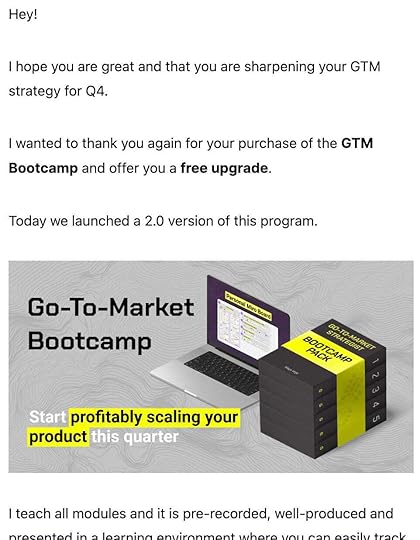 Email to existing buyers
Email to existing buyersThe only way this will work is if you trust me to deliver and I trust you to execute.
That is our social contract if you decide to go on this journey.
I know what you are thinking now … “But Maja, I do not have the budget and I do not have access to influential people in my network.”
I did not, either. I worked extremely hard to build these relationships that I honor. You see, I live in a small village in Slovenia, and I do not go to $5,000 conferences and mingle with VIPs at networking events. I work, and I let my work do the talking for me. In reality, we have very little to offer when we are starting. We build our way up by producing good work, supporting others' work, and being helpful to them.
 Credit: James Evans, co-founder at Command AI
Credit: James Evans, co-founder at Command AIGive first - do not be impatient or too greedy. Relationships take time to develop. Sometimes it will not yield results - and that is OK. It should not stop you from being outrageously generous because when it works, it is just incredible. Reciprocity 🙏
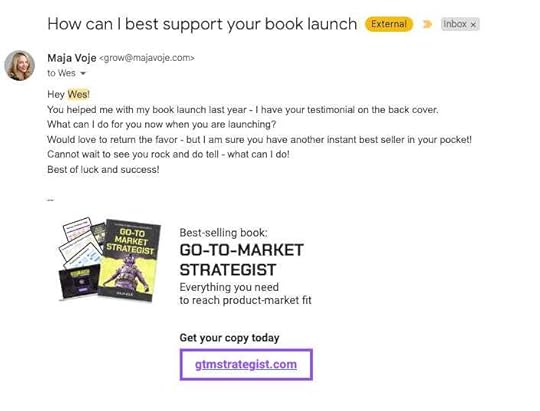
I started a GTM advisory role for an AI platform for influencer management developed by a product manager at Instagram (Meta) in Silicon Valley. We are pre-launch, but we are already testing the platform for some selected campaigns with the companies that you know, but I cannot name them yet.
If you would like to run a pro bono campaign with them and work closely with the team to improve the product based on your feedback, let me know, and I will say a good word for you for a free additional relevant reach on LinkedIn if you are a good fit.
5. Do not “let go” when it comes to creating a good landing pageYou have been working non-stop on making your product AMAZING and have invested so much to make it great. By this point, you are tired and you cannot wait to get it out there.
But don’t ship half-baked landing pages. I am not a copywriter and I had 5-figure launches with Google Docs and Notion pages before - but that does not mean that I do not believe in the power of a great landing page to support your launch.
As a founder - no matter how tired and distracted you are at this point - you need to sit down and do the proper landing page briefing for your team.
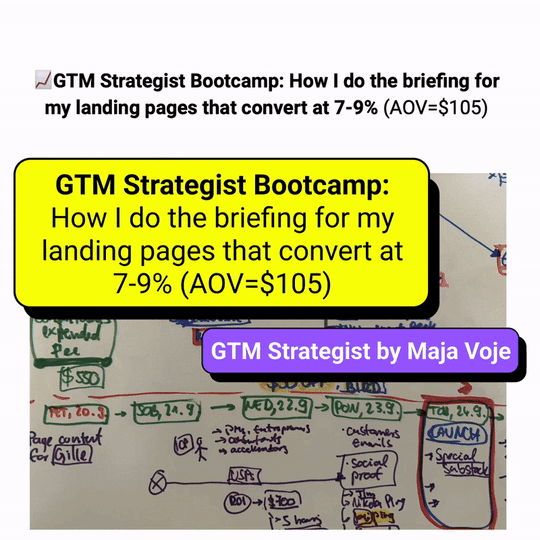
People cannot read your mind and while you can do everything yourself, some of us are just not copywriters, we are more passionate about product development than developing catch headlines. We might have blind spots by now because we know the product too well and 100% believe in it, so our ability to empathize with a website visitor who is just learning about the solution could be highly unreliable.
But you are the only person who knows everything and you have to set up your people for success. This is how I do the briefing for my team. It takes me a deepwork slot of 3-4 hours to do this right.
Here is the exact document that I sent to my team 14 days ago. No strings attached—just open the Google Doc 👇
In the Slavic world, we say not great, not terrible - but based on these inputs, we did manage to create a landing page that converts 7-9% for the third time around. These conversion rates drop in time when we bring colder audiences to the page, but since April, there was not a single week where the conversion rate (CR) was <5% so we are doing something damn right. Our AOV (average order value) has been >$100 since June. I am not sharing these numbers to bloat but to give you relevant context about the environment in which this is reported and that it has tested longevity, that we did not measure this just on a launch date when CR can be up to 15%.
Thanks a million to my incredibly hard-working team and all the AMAZING experts in my network who kindly supported the launch 💟. I could not have done it without you.
Now I finally need a weekend off. I have been up at 4-5 a.m. every day for three weeks. Need to catch up with my tranquility.
Have a great weekend! You can still snatch the GTM Strategist Bootcamp for $50 off by Monday, September 30th. The coupon code GTM50 expires at midnight.
Recommended further related readings
How we launched GTM Strategist Checklist with a Content Growth Loop on LinkedIn 🔁
How to work with B2B Influencers and an even more tactical sequel of this article
Case studies - you have to have a case study for your sales. Please learn how to sell with case studies. It will boost your business to new heights.
PS - Just a gentle reminder to do OKRs or whatever else you use for goal-setting. Q4 starts next week - let’s make it epic 🤘
Are you ready to dive deeper and work on your Go-To-Market strategy and execution?Discover my solutions that support your journey from launching to scaling:
🛰️ Explorer: Understand Go-To-Market and develop a winning GTM plan.
Get best selling GTM Strategist book + 20 frameworks (workshops) + online course ($47). Tested by 6500+ companies
🚀 Doer: Leverage the 100-step GTM Checklist tested on 650+ launches with templates (emails, launch plans, posts, landing pages), which will guide you from getting ready to launch to an impactful launch and scaling stage.
Get the Checklist ($97)
💫 Leader: Guide your team to successfully choose ICP (target market), pricing, positioning & selection of best GTM Motion (channels, tactics). GTM Bootcamp includes 5 hours of applicable videos and a personal Miro board.
Get the Bootcamp ($347)
🏆 Ready to win: Tackle the most pressing Go-to-Market issues such as selection of ICP, positioning, how to get customers, build teams and select proven ways how to go to market. Book a 90-minute hands-on consultation with Maja, get personalized guidance, a Miro board, and reliable vendor contacts for further work.
Book here for $500

September 24, 2024
Announcing the GTM Strategist Bootcamp 2024/2025
Dear Founder, Marketer, and Product Manager,
After working with over 700 companies and leading projects at Google, Bayer, and Heineken, I’ve realized one thing: group cohorts don’t work. They’re inefficient, scattered, and fail to deliver the kind of results you need to scale profitably.
When you're in the thick of launching or scaling a product, you don't need:
Group classes full of theory that aren’t directly applicable to your situation
Fixed schedules that disrupt your day or make you feel like you’re falling behind
Endless content that wastes time when you need actionable insights
What you do need is:
Clear, focused strategies that drive growth
Proven methods from businesses just like yours
Real case studies of successful GTM strategies that you can replicate
Direct, honest feedback on what’s holding your business back
Execution Over InformationYou don’t need more theoretical knowledge - you need execution. That’s why I’ve made a big change. No more group cohorts. Instead, I’m offering two focused paths for 2024/2025:
DIY: Access the entire GTM Bootcamp curriculum to work through at your own pace.
Done-With-You (DWY): I work directly with you through intensive 1:1 sessions.
The GTM Bootcamp 2024/2025: A Step-by-Step System to Launch & Scale ProfitablyThis bootcamp is a comprehensive guide for founders, product managers, and marketers looking to create a predictable, repeatable growth engine. We’ll cover everything you need to know to take your product to market and generate traction, even on a limited budget.
By the end of the Bootcamp, you’ll know how to:Identify and reach your target customers with laser-focus
Craft messaging that turns leads into loyal customers
Price and package your product for profitability, even before you run out of funds
Choose GTM Motions that generate the best ROI with minimal upfront investment
Build growth loops that bring in customers consistently
What You’ll Learn:Each module is designed to help you launch and scale efficiently, with real-world case studies to guide your decisions:
Module 1: The GTM Power Hour Framework
Create your one-page GTM plan using a framework trusted by 650+ companies. This plan will serve as your GTM “compass,” constantly refined as you progress.
Module 2: Early Customer Profiles (ECP)
Learn why and how you should focus on your Early Customer Profiles - the ones who will give you traction, feedback, and testimonials-before targeting your Ideal Customer Profile (ICP).
Module 3: Positioning and Messaging
Develop a strategic narrative that sets you apart from competitors, and use our clear positioning framework to create high-converting websites, ads, and copy.
Module 4: Pricing & Profitability
Test and optimize pricing strategies before making changes, so you can maximize profit while maintaining product adoption.
Module 5: Selecting Your GTM Motion
Discover which GTM Motions will drive your first wave of growth. You’ll also dive into case studies of fast-growing companies and learn which strategies worked (and didn’t) at different stages.
This isn’t just theory. I’ve spent a decade driving growth for tech companies and organizations like Google, Rocket Internet, and OriginTrail, where we raised $22.5M and built a 150,000-strong community.
Hear it from GTM Strategist Heros:
“Booked over 200 B2B meetings in 80 days.” – Javi
“Welcomed over 600 free users and 30 paid subscribers in under 60 days.” – Alexiomar
For Builders of Great ProductsThis Bootcamp is ideal if you’re:
A Founder of a B2B SaaS startup or scale-up, ready to master GTM strategy and drive hyper-growth
A Product Manager looking to expand your growth and marketing skills to climb the career ladder - or build your own business
A consultant or VC who needs proven GTM frameworks for your portfolio companies/clients.
In short, if you’ve built something great but need help turning it into a scalable, profitable business, this Bootcamp is for you.
Choose Your Path: DIY or Done-With-YouDIY: GTM Bootcamp Pack
Includes the full content with practical case studies, actionable exercises, and video lessons for $347 (normally $447).
Done-With-You (DWY): Personal Coaching
This package additionally includes a 30-minute prep session and a 60-minute workshop with me to tackle your specific GTM challenges head-on. Priced at $997.
If you don’t find this bootcamp valuable, we’ll refund your payment 100%—no questions asked. We’re committed to your success, not just your enrollment.
Ready to See Real Traction?Enrollment is now open, but spots for personal coaching are limited. If you're serious about accelerating your growth, this is the best time to start.
Got questions? Email me at grow@majavoje.com, and I’ll help you decide if this is the right fit.
Don’t miss the chance to grab early bird pricing with code GTM50 for additional $50 off - available until September 30.
Invest in Your GrowthIt’s time to take action. Dive into the GTM Bootcamp, gain clarity, and start scaling your business profitably.
I look forward to working with you.
Warmly,
Maja Voje
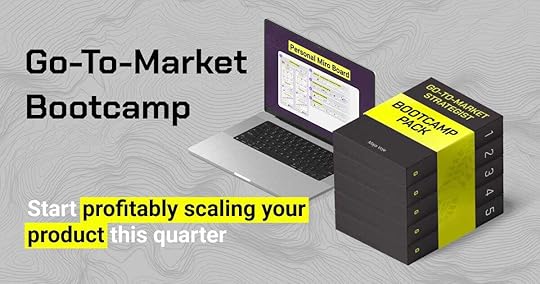 P.S.: See It in Action
P.S.: See It in ActionIf you’d like a sneak peek, join me and Guillermo Flor, a Venture Capital Investor at GoHub Ventures, for a live online event. Together, we’ll break down GTM strategies and walk through real case studies from companies like Gusto ($9.5B valuation) and Notion ($10B valuation).
You’ll see exactly how we approach GTM motions and tackle real-world challenges. Bring your questions!
September 20, 2024
Riding, Surviving, or Thriving the AI Hype?
In this edition:
How AI products go to market - my upcoming case study for Product Drive
Does it make sense to pay more than $100k for an “.ai” domain?
A free guide to AI SaaS pricing - with a cheat sheet
An alleged shady background of LinkedIn’s “Top Voice” badges
Dear GTM Strategist!
How is your September?
It is a crazy month in my “HQ” = home office. Look at my dungeon 🤠
 Behind the scenes of “filming” the new version of the GTM Strategist Bootcamp
Behind the scenes of “filming” the new version of the GTM Strategist BootcampWe are working on a new version of the GTM Strategist Bootcamp with my team; I’m preparing for the Q4 event tour and hedging my strategic bets for 2025.
One of these bets continues to be GTM for AI-first companies.
And before I enthusiastically write another AI-related Substack, I need to measure the temperature here - are you even interested in this?
Help me out by stating your opinion here:
Thank you!
But before I hear back from you …
🥁🥁🥁
Here is what is HOT right now in my network:
How Do AI Companies Really Go to Market?0 theory, 0 budget, real experiments, and lessons learned. I developed a case study for Userpilot’s event, Product Drive. There will be many fantastic sessions with Marty Cagan, Wes Bush, Ben Williams, and David Pereira …. The stakes are very high. This is why I have been working on this presentation for over a month now, and here is a special preview for you (work in progress):
Over 2000 people have registered so far, and we anticipate 3500+ 🙀 (not nervous, no, no).
Worth your attention?
Join us on a livestream on Oct 7th and Oct 8th.
🇮🇪 If you are in Dublin, let's meet in person. 🤝 Join us on 8 October.
Register here. It is free. 🤠 I sent 50 books to Dublin - you can get one as a 🎁 if you attend.
Rebranding: Goodbye CommandBar 🔛 Hello Command AI 👋Does it make sense to pay more than $100k for an “.ai” domain?
James Evans, co-founder of CommandBar—oops, I mean Command AI—made a bold move: they rebranded their user assistance platform (trusted by teams like HubSpot, HashiCorp, Yotpo, Thryvv, and Freshworks), to an AI-first product. I was curious why the team rebranded since many of my VC friends are scared that we are at the peak of the genAI hype curve.
James explained why they decided for a rebranding:
“It came down to the fact that the key problems we're trying to solve are uniquely enabled by AI. Our company exists because we think most software is way too hard to use, and stuff that exists to help users (old school popups and chatbots) are more annoying than helpful. Why annoying? Because they aren't personalized. Chatbots tell users to "go read these 3 FAQ articles". Pop-ups randomly spam users with new features and offers for onboarding tours.
See Command AI in action:
Command AI mimics how a human user assistant would work. They would stand next to the user at their computer and be able to answer questions with the full context of who the user is and what they have asked before. They could take over the mouse and just show the user when needed, or give them a nudge in the right direction when they seem stuck.
Along with the rebranding, Command AI announced two new AI-powered features this week: copilot cursor:
and nudge autopilot:
Great products with sustainable business models will outlive any hype. User assistance is ripe for AI disruption. Everyone has an annoying experience with automated chatbots that didn’t get you the answer.
If you want to take Command AI for a spin - you can book a demo here.
New Report on AI SaaS PricingPricing AI can feel like a moving target. That's what happens when a new technology is evolving at hyperspeed. Thankfully, my friends at PricingSaaS published a Guide to AI Pricing, jam-packed with examples from some of the top players in SaaS. Grab the full report below.
 Grab the report at https://pricingsaas.com/aiGuide/
Grab the report at https://pricingsaas.com/aiGuide/Go-to pricing strategies ATM:
Usage-based
Seat-based
Hybrid (combining seat and usage)
In addition to general stats, this report also provides interesting examples and differentiations between new products, features, and upgraded packages such as:
Notion: Seat-based AI add-on increased ARPU by 80%
Algolia: Usage-based model with $0.50 per 1,000 search requests
Airtable: Hybrid model combining $6/seat add-on with usage credits
Every Trend Has an Anti-Trend: Human Interaction Matters More Than EverI totally went outside my comfort zone by doing an interview with Aakash Gupta. I was so honored that he invited me to the show, but you know how it is - he has 200K LinkedIn followers and 120K Substack followers and I was like - “OMG - this is huge.”
But based on the first feedback from our communities, we did a great job. My favorite part of this nearly 2 hour-long interview is when we discuss the future of GTM 🔮. Whereas I firmly believe that GTM Engineering is something we should learn—hello, the subtle art of prompting—I believe that we should double down on human-centric: sales, networking, events, partnerships, etc.
To take it up a notch: Richard van der Blom believes that AI is ruining LinkedIn and the only way to really thrive there is to be a HUMAN.
He saw a 340% increase (!!) of AI-written comments. He shared the numbers here.
👽 Conspiracy Theory or a Real Story: LinkedIn Allegedly Trains Their AI With “Community Top Voices”My friends Ivana Todorović, co-founder at AuthoredUp, and Jason Knight from One Knight in Product recorded the best podcast I have ever listened to about LinkedIn for regular folks, not full-time LinkedIn Bros.
Ivana shared stats of her epic LinkedIn Algo study. She gave the best explanation ever on why we had the “honor” of sharing our wisdom with Community Answers on LinkedIn last year - allegedly, we were training their AI 😆 by earning and defending the “Top Voice” community badge - LOL. Since I fell for it last year, I thought it was interesting to share. There are many more hands-on nuggets and tangible tips in this interview, so definitely listen to it if you would like to succeed on LinkedIn without sacrificing your moral compass and wasting too much time that you don’t have in GTM.
If that bothers you, check out this post by Paweł Huryn to learn how to opt-out of LinkedIn harvesting your data to train AI.

Now, I’m back to #deepwork 🫡 and finishing the bootcamp.
Thanks for reading and thinking with me!
Till the BIG launch next week!
Maja from the dungeon 🐲
 In 2018, community members at OriginTrail, where I was CMO during $22.5 million fundraising, made this cool meme of me as Khaleesi - I loved it then.Are you ready to dive deeper and work on your Go-To-Market strategy and execution?
In 2018, community members at OriginTrail, where I was CMO during $22.5 million fundraising, made this cool meme of me as Khaleesi - I loved it then.Are you ready to dive deeper and work on your Go-To-Market strategy and execution?Discover my solutions that support your journey from launching to scaling:
🛰️ Explorer: Understand Go-To-Market and develop a winning GTM plan.
Get best selling GTM Strategist book + 20 frameworks (workshops) + online course ($47). Tested by 6500+ companies
🚀 Doer: Leverage the 100-step GTM Checklist tested on 650+ launches with templates (emails, launch plans, posts, landing pages), which will guide you from getting ready to launch to an impactful launch and scaling stage.
Get the Checklist ($97)
💫 Leader: Guide your team to successfully choose ICP (target market), pricing, positioning & selection of best GTM Motion (channels, tactics). GTM Bootcamp includes 6 hours of applicable videos from top experts.
Get the Bootcamp ($197)
🏆 Ready to win: Tackle the most pressing Go-to-Market issues such as selection of ICP, positioning, how to get customers, build teams and select proven ways how to go to market. Book a 90-minute hands-on consultation with Maja, get personalized guidance, a Miro board, and reliable vendor contacts for further work.
Book here for $500
September 13, 2024
Tactical Partnership Guide 101: How to Go From 0 to 1
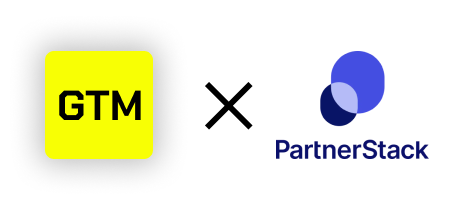
This post is kindly supported by PartnerStack, an all-in-one platform specialized for B2B SaaS. More than 500+ brands, such as Apollo.io Typeform, Zoom Info, PandaDoc, Thinkific, Freshworks, Vidyard, and many others, trust PartnerStack with their partnership management.
After reading this Substack, you will know:
What first-level partnership principles Silicon Valley unicorns 🦄 use to generate tens or hundreds of millions of dollars in partnership programs
How to find a perfect partner: 4Cs Framework
5 types of partnerships to consider for your Go-to-Market strategy
How you can DIY on your Partnership Strategy based on reliable frameworks
How to build a 360° Partnership System with PartnerStack
🥁🥁🥁 Roll out the red carpet:

Nelson Wang, Founder of Partner Principles and Head of Worldwide Partnerships at Airtable, will present you the Partner Principles he used to build partnerships from zero to one at Box, Miro, Airtable, and Optimizely. He has built 1700+ partnerships and created $150M million of revenue with partners.
Let’s do this!
Dear GTM Strategist!
You know that Partnerships are among the most essential GTM Motions and work incredibly well for complex tech products and services, right?
Based on the survey of GTM Partners, 66% of companies said that partnerships are their key GTM Motion. In our community survey, that number is 40%. So we are definitely onto something here …

In my business, partnerships account for 35% of sales. 90% of this sales comes from 3 partners. I frequently collaborate with other content creators and I am quite positive by now that the formula of expected sales from a good placement (content + their take + CTA) goes like this:
# of their Followers x 0,013 = Sales Target
I try my best to nurture them and build new partnerships, but once again - since I just had a touchdown on my Product-Market Fit, things are still hectic. We are slowly but firmly building processes and SOPs.
I can no longer rely on my memory to ping Jakob from Swiss EP after 4 months and that we could do something together again. We need a system.
If you are thinking …
“Hmm—how cool would it be if someone else made the sales instead of you?” Hold your horses.
Do not start by exporting your contact list to spray your sales deck with a fuzzy promise that they will get 20-30% of the sales they bring to you just yet. 🤠
You will likely get burned!

The issue is…
99% of such “Partners” will fail to produce ANY traction and probably the nicest reply you will get is “OK, I will keep that in mind”. And you and I both know that you will forget to follow up on these replies.
You need a strategic approach and a system for managing partnerships to turn Partnerships into a well-coordinated, repeatable and scalable GTM Motion.
Let’s learn from Nelson 🙌
Here is his Mega-deck called the “Partner Starter Kit” with FREE frameworks (88 FREE slides) that you can start using immediately:
 https://www.partnerprinciples.com/Partnerstarterkit
https://www.partnerprinciples.com/Partnerstarterkit✍️ And of course, I made some notes and invited Nelson to share more examples with you ❤️
Nelson’s strong point of view is: “Successful long-term partnerships are based on first-principles thinking. You can have some success with tactics and ad-hoc action and if you’re really lucky, you may even get to scale with that approach. But the key to unlocking Partnerships as sustainable and growing GTM Motions is to build partnership strategies based on fundamental principles that act as your north star. As an example: One of the most important ones is to be customer-centric.”
Nelson knows from experience that a clear and well-thought-out Partnership Strategy is the key to a robust Partnership Program. He kindly shared some of his best frameworks with you to help you get started.
Understand ICP and its Customer Journey Map (CJM) firstEverything starts with you mapping the end customer journey and knowing your ICP inside out. Only after you understand the CJM can you rightfully estimate at which points do partnerships make sense and deliver value for the end customer.
 If you haven't completed your CJM (Customer Journey Map) yet, now is the time to do it.
If you haven't completed your CJM (Customer Journey Map) yet, now is the time to do it.Suppose you are a complex CRM such as Hubspot or Salesforce. In that case, it makes sense to consider reselling partnerships with local agencies that help onboard customers and address their specific needs for customizations. If you sell software for upsells in hotels, partnering with local consultants to get your foot in the door of bigger hotel chains and help them adopt the program would make sense. Where do partnerships make sense in your CJM?
Nelson Wang shares an example from Hubspot (Source: Partnerinsight.io): Hubspot has a massive solutions partner program where partners offer CRM, IT/Integration, Web Dev, Marketing, and Sales Services to customers to help them on their journey. The results of this ecosystem approach? “Partnerships are the engine driving HubSpot's growth, contributing a staggering 45% of its revenue in 2022 and referring 33% of their customers. Not only are these partners driving almost half of the revenue, but they're also bringing in customers who pay more than the average.”
4Cs of Ideal Partner ProfileBuilding partnerships usually does not start with an outbound challenge to get as many partners as you can recruit. A massive number of partners with no focus or clear reasons as to why does not lead to success. It leads to noise.
Nelson Wang developed a useful framework, 4C of Partnerships, which helps you determine your Ideal Partner Profile by understanding:
Capacity - Company size, customer portfolio, team
Capability - Their expertise and proven part experience, and other key partnerships
Commitment - This has to be double-sided - same as you are interested in building the partnerships, they should also devote resources and time to making it worth.
Customers - Synergies are crucial - the partner must have access to the same economic buyer that you target. If not, you have a huge hill to climb that is often insourmountable.
 Oh, look, a Partnership Persona 🤠
Oh, look, a Partnership Persona 🤠Prioritize your partnership activities (80-20% Rule)
The Pareto principle applies to partnerships, too.
20% of Partners will produce 80% of results in a scaled Partnership program.
Like many things in GTM, partnerships are not set-and-forget-it. To create a long-term partnership, you need to invest in educating, onboarding, and activating your partner, and you often need to give them business first.

Here are the best practices that you can use:
Align goals from the start. When you are negotiating the partnership agreement, it should be crystal clear to both parties what success looks like:
What are their goals?
What are your goals?
What are shared goals?
When will you value the partnership? What are the timeline and milestones?
How often should we check in with each other?
What communication line suits the partner - Slack community, partner resource center, email communication, or in-person meetings?
Accountability system - biweekly check-in, quarterly review, and ownership of the partnerships are well defined on both sides of the deal.
To set up the right metrics and KPIs, we need to understand the types of partnerships first.
5 Types of Partnerships according to Nelson Wang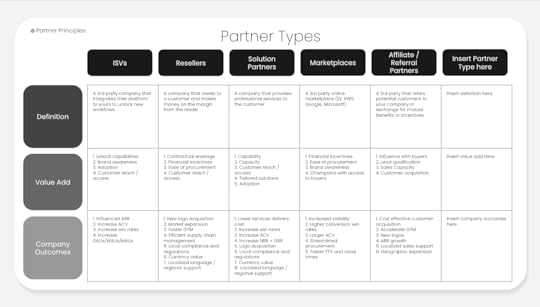
Now that you understand which stages of the customer journey partnerships could add the most value, you can start deciding which partner types to focus on.
For technology companies, Nelson defines 5 types of partnerships but qualified that different companies will different types of partners. This slide above is only meant as a starting point to help you ideate.
Here were the 5 on his initial list:
Independent Service Vendors - ISVs
Resellers
Solution Partners
Marketplaces
Affiliate/referral partners
He leaves room for you to customize this framework. In our podcast, we also discussed GTM Partners. You do not have to fix the boxes here. You have to develop partnerships that complement your customer journey and bring the biggest value to the end customer, your partner, and yourself.
Want more?
If you want to dive deeper and DIY your Partnership Strategy, I recommend the Partner Strategy Deck template (with a one-hour training video).

Nelson structured his learnings and best practices of building partnerships from zero to one at Box, Miro, Airtable, and Optimizely, leading to $150M+ in partner revenue. This deck took him 80 hours to put together and will save you countless hours and iterations.
I bought it with my own money, and I can assure you it is very useful.
But hey, don’t only take my word for it. The CEO of Workramp, CSO of WriterAI, Founder of Euler, Senior Partner Development Manager at AWS, the Founder of Hockey Stick Advisory, and manyothers think so. In fact, over 5,687 others have used his partnership templates to date! You can also see the list of testimonials here in the middle of the page. 😉
I asked Nelson to gift a Promo code to the readers of the GTM Strategist Substack.
You are welcome ✌️
You can use the promo code: MAJA to receive 30% off any his products and services on his site. We recommend starting with his flagship strategy training and template here and you can explore his other templates here as well.
The code is only valid till October 2024.
Establish a 360° partner collaboration system to do it at scaleNow that you know who your successful partners are and how to activate them to unlock successful partnerships it is time to scale the partnership program. Now we are talking about Partnerships as a serious GTM Motion, not random campaigns.
You want to create a system of finding, activating, managing, tracking, compensating, and optimizing collaboration campaigns in a single place. These are jobs to be done:

Here are the inspirational results that you can expect by investing in a full-fetched system of managing your partners, resellers and affiliates:
Apollo.io earns 10% of its revenue through its partner program
PandaDoc grew monthly recurring revenue by 47% YoY
Vendasta drove over $1.8M in affiliate program profits in less than 2 years
These examples are taken from PartnerStack, an all-in-one platform specialized for B2B SaaS. More than 500+ brands, such as Apollo.io Typeform, Zoom Info, PandaDoc, Thinkific, Freshworks, Vidyard, and many others, trust PartnerStack with their partnership management. G2 awarded PartnerStack the top-rated Partner Ecosystem Platform.
Here is how it looks in practice.
Even if you are not there yet, please watch the video because it will inspire you to take your system to the next level beyond timely and ineffective email correspondences.
If you have the audience or clients yourself that use SaaS solutions listed in PartnerStack Marketplace, you can even consider applying for becoming a partner yourself. The service is free and if you recommend this softwares anyway, why would you not make some money for promoting it too?
So what will it be, dear GTM Strategist?
You invested 5-10min in reading this post.
Which action points are the right ones for you to take next?
You are welcome to share your thoughts and questions in the comments 💬 (I reply to them!) all and hit ❤️ on Substack if you enjoyed this one to signal me that I should create more content like this to support you on your GTM endeavors.
Proof:
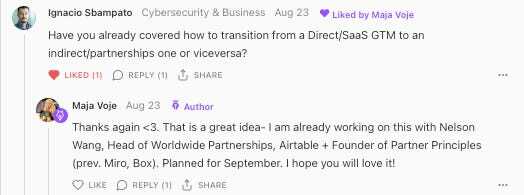
Let’s go to market!
Stronger together 🤝
- Maja
P.S.: Join me this Monday, 16 September, on a 📹🔴 LinkedIn Live Audio Event with Richard van der Blom. We’ll discuss a game plan for using LinkedIn to build your brand and generate leads.
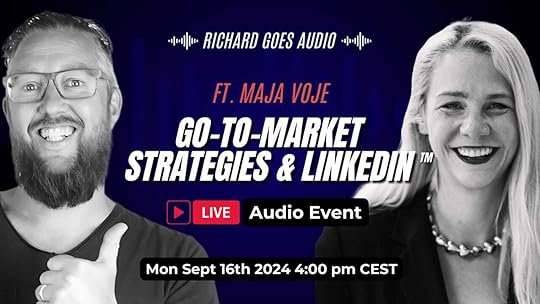 Are you ready to dive deeper and work on your Go-To-Market strategy and execution?
Are you ready to dive deeper and work on your Go-To-Market strategy and execution?Discover my solutions that support your journey from launching to scaling:
🛰️ Explorer: Understand Go-To-Market and develop a winning GTM plan.
Get best selling GTM Strategist book + 20 frameworks (workshops) + online course ($47). Tested by 6500+ companies
🚀 Doer: Leverage the 100-step GTM Checklist tested on 650+ launches with templates (emails, launch plans, posts, landing pages), which will guide you from getting ready to launch to an impactful launch and scaling stage.
Get the Checklist ($97)
💫 Leader: Guide your team to successfully choose ICP (target market), pricing, positioning & selection of best GTM Motion (channels, tactics). GTM Bootcamp includes 6 hours of applicable videos from top experts.
Get the Bootcamp ($197)
🏆 Ready to win: Tackle the most pressing Go-to-Market issues such as selection of ICP, positioning, how to get customers, build teams and select proven ways how to go to market. Book a 90-minute hands-on consultation with Maja, get personalized guidance, a Miro board, and reliable vendor contacts for further work.
Book here for $500
September 6, 2024
Is GTM Engineering 🧰 the way to scalable growth?

💡 In this Substack post, you will learn:
That outbound is not dead (if you do it right) - data from my proprietary survey.
Exclusive FREE online course: Patrick Spychalski, Head of Content at Clay and Founder of Kiln agency, recorded 2 hours of hands-on materials that will guide you to your first successful outbound campaign.
What is GTM Engineering - Alex Lindahl has been a part of 7 Series A early GTM teams (3x 🦄). What does he do as a GTM Engineer and how can you and I learn GTM Engineering?
Dear GTM Strategist
Working on executing the GTM strategy can be daunting.
There are so many pieces of content to produce, emails to send, and data to find.
Who has time to do it all? 💀
Since you have 3-6 months to make or break it, you probably don't.
Work smarter, not harder.
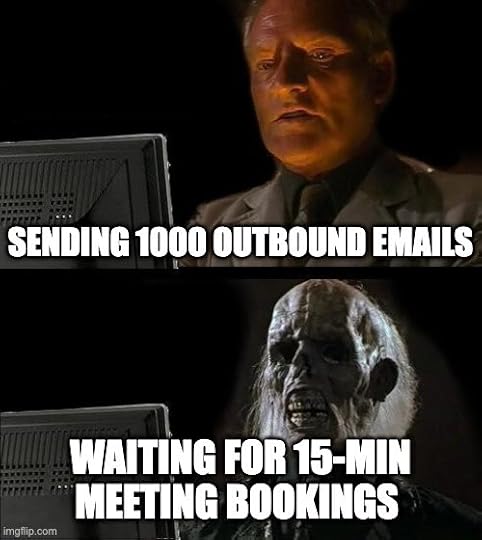 Outbound is not dead. It works if you do it right.
Outbound is not dead. It works if you do it right. Gang, I have a confession to make - I do outbound.
Ultimately, there are two ways how customers learn about new products:
They see it on the platforms where their attention already is …. Or …. Wait for it …
You proactively tell them that you exist and pitch what problems you can solve for them.
On average, I reach 200,000 people organically on LinkedIn every week.
Out of that, I get 3-5 leads a day- approximately 30 leads a week.
80% of those leads are not my ICP, so I end up with 6 good leads weekly.
Do I sit around, attend intro meetings, and maintain the status quo while the LinkedIn algorithm changes?
Imagine if I could proactively put together a target list of my ICPs, craft a message about what value I can deliver to them, prove that I can do it, and provide value for them immediately.
That is called outbound. 📬
And apparently, I am not the only one doing it.
We did a quick survey in July on LinkedIn. 198 kind community members pitched in. When I asked Which GTM Motions work the best for you right now? Here is what you said:
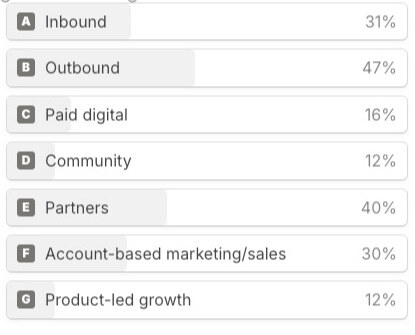 *The % does not add up to 100% because it was a multiple-choice question
*The % does not add up to 100% because it was a multiple-choice questionIf you are wondering where on earth this comes from, here is the company structure so you can make a better sense of these results:
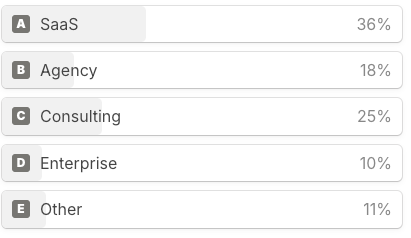 I wonder what Other is … Any government officials here?
I wonder what Other is … Any government officials here? Next time we run such a survey, I will make sure that the sample is much larger so we can properly segment the data, but yes, many businesses see great results from outbound.
But here is where it gets REALLY REALLY interesting. I also asked the respondents an open-ended question: What challenges do you have regarding outbound? I analyzed the data. ChatGPT is still good for that 🤠

We have and CAN do better than this.
I forwarded these results to the content manager at Clay Patrick Spychalski…
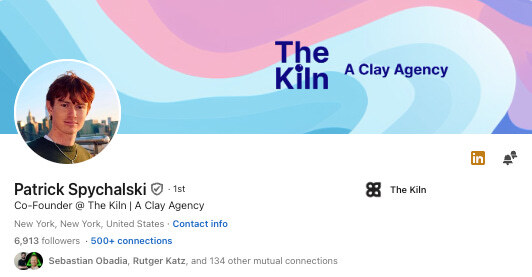
…and asked him to provide some guidance for our community.

He massively over-delivered 🙌 so instead of an email course, we present:
🥁🥁🥁

Clay x GTM Strategist Outbound Email Crash Course
🔮 Is GTM Engineering the future of GTM?During our podcast recording, product leader Aakash Gupta asked me, “Where do you see the future of GTM?” My top-of-mind answer was “GTM Engineering.” Here is why …
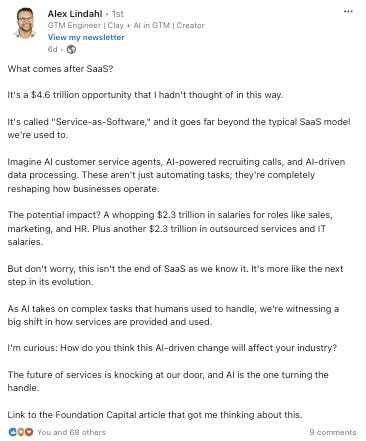 OG article: https://foundationcapital.com/ai-service-as-software/
OG article: https://foundationcapital.com/ai-service-as-software/ You know how much I like the idea of AI and automation handling daunting tasks so my team and I can focus on exciting things that make a massive impact.
Up to 70% of business development and sales work are supremely BORING CRM tasks, admin work, finding data, and following up … 🤢 not for me …
How about you?
So, I went on a mission to discover how you and I can become GTM Engineers.
Alex Lindahl caught my attention 👀

Alex Lindahl has been a part of 7 Series A early GTM teams. Three have become unicorns and maybe Clay will be the fourth. He writes about all things GTM engineering, automating workflows with Clay, prompt engineering, and the future of GTM on his substack, Claymation: www.clayautomation.com.
So I invited him to answer a couple of questions for you and me to understand what GTM engineering is all about and how we can use it to craft winning GTM strategies. Hear it from Alex:
What is GTM Engineering?Most sales motions today include an Account Executive (AE) and Solution Engineer (SE). AE manages the business relationship and overall sales process, and the SE manages everything technical (demo, technical questions, running a POC).
Clay decided to combine the two roles into what we call a GTM Engineer. (Hat tip to Co-Founder, Varun Anand, and GTM Engineers, Andrew Malacrea and George Dilthey who developed this vision & title.)
But, what do we do?
At its foundation - we help customers engineer new types of GTM solutions with Clay. Similar to software engineering, GTM engineering takes a systematic approach to designing, developing, testing, and maintaining GTM systems. This could be designing automations, workflows, or data orchestration between different components of the GTM tech stack. This includes custom data sourcing & enrichment, AI prompt engineering, automating manual processes, building workflows between disparate tooling, and using SynthAI and GenAI to automate manual research (for sales reps) & content at scale (such as personalized emails).
Think of a website - it has multiple components; videos, content, web forms, interactive content, and so on that all work together for a cohesive experience. Now think of the GTM stack. It’s gotten overly convoluted, clunky, bloated, and not much is talking to each other to create a similar experience for users..
Our ultimate objective is to help companies run on better data intelligence, automate away unnecessary tasks, and improve overall GTM team efficiency to increase productivity and revenue.
To accomplish this - we work with customers to understand their unique ICP data needs, what parts of the tech stack need to be integrated, what databases (from within our data marketplace) to source this information, write custom AI prompts to automate manual research at scale with our AI agent, connect tooling with APIs, and orchestrate all of these workflows.
Here’s an example in the context of an AI language translation company.
Their objective is to figure out 1) what accounts are the best to go after (have the most pain, likely to convert at high ACV), 2) gather intelligence to score the accounts & create positioning, 3) find the right people, 4) arm the reps with the data in a concise, usable form.
For those that aren’t familiar with 10-Ks - they are annual reports that public companies publish once a year on the state of the business. This includes a treasure trove of information such as key priorities, where they are investing, what metrics they need to improve, key risks to the business and much more. Top enterprise reps use this information to form a hypothesis on business needs and to position their solution from initial conversation to proposal.
Build a list of Fortune 1000 companies
Find all of their 10-K reports
Analyze those 10-K reports to figure out
Where are they expanding?
How many countries do they operate in?
Are they launching new products?
Now analyze the company’s website
How many languages is the site translated into?
Does the website have a training portal?
What’s the name of the training program?
Find recent news on the company related to country expansion
Use AI to analyze whether they have a gap in the number of countries they operate in, the number of languages their website is translated into, and how many countries are non-English speaking and would need additional translated website copy or training materials.
Figure out how big the Learning & Development team is
Score the accounts
Lookup the record in Salesforce if they have existing contacts
If not, find new contacts at the account
Create a research report on the company for the rep
Send all of the data on the company into Salesforce, the research report to the AE via a Slack notification, and the personalized emails into an email cadence.
There could be many more steps too. Such as looking up data in niche databases they may have a subscription to, or sending data into a video creation tool to create personalized videos at scale.
This is all GTM engineering. Thinking through the requirements, connecting APIs, AI prompt engineering, and bringing this all together into a custom solution that is automated. Finally, sprinkling in creative thinking so that you can help the customer think differently about their GTM approach, campaigns, or new ways applying AI and automation.
This is what we do as GTM Engineers inside Clay. However, we’re quickly seeing this role emerge within organizations themselves. I’ve even come across a pre-IPO security company that has a “GTM Engineering” org. The title is also starting to pop up. I truly believe this trend will continue and become mainstream within GTM.
Can you share examples with results?Some SDRs spend 1-2.5 days per week on list building and research. It’s very common for us to be able to automate away 90-100% of this work so they can spend more time prospecting.
Same thing with RevOps and Sales, we’re often saving 1000s of hours of manual work.
In other areas, we’re increasing speed to lead so that enrichment personalized email response is within minutes.
We’re really just at the beginning here and we’ll be publishing more case studies.
Is it a fancy word to say that we should automate and use AI?It’s more than just automation and AI. This is thinking about systems and processes more holistically. Not only how everything works together, but also how the engineer system fits into GTM team members’ daily workflows & habits.
We’re seeing a move from Software-as-a-Service to Service-as-Software. You can think of GTM Engineering as helping engineer the system that provides the service. Or, at least at Clay, we’re providing both Software and building the Services that are delivered through the Software.
Our vision is to be the ultimate creative platform for GTM teams.
What personally led you to identify as a GTM engineer?I’ve always found myself drawn to understanding the technical aspects of what I sell. So, being able to get more technical, apply those skills, and build solutions for customers was really appealing. Plus, I was craving more creativity in my professional career. I needed something different from your typical AE role. I’ve never had so much fun in a role helping customers and building what I always wanted to have as a seller.
Where can companies apply GTM engineering?GTM Engineering to functional areas outside outbound
Customer Success - you can use signals/research to learn earlier in the customer lifecycle if the account is at risk.
Venture Capital - some firms are building “Clay-as-a-Service”, or think “Intelligence-as-a-Service” to their portfolio companies. Other use cases, are tracking their networks (when an Exec leaves to start a company), or tracking their portfolio company.
Angel Investing - I’ve used Clay to source investment opportunities.
Recruiting - I came across a pretty interesting use case the other day that used Clay to analyze growth trends of companies and where their competitors were placing reps.
Does any other company have GTM engineers?We are starting to see Clay as a requirement in job postings. This trend is gaining momentum and 100% foresee the GTM Engineer title becoming more prevalent, too.
How can you learn GTM Engineering?There’s a ton of resources to learn Clay. Learn Clay, get creative, and as a result you learn GTM Engineering. I’d also recommend learning how to do prompt engineering. The basics are rather straightforward, but it does take a while to be proficient with the nuances and to get really good outputs.
Here are a few places to get started:
Clay University - learn the building blocks.
Clay Cohorts - two week program with a curriculum.
Clay Community - Clay’s slack for community support & everything Clay
OpenAI Prompt Engineering Guide - to learn prompting
Perplexity.ai - great for synthesizing best practices on prompting & asking follow-up questions
Anthropic Prompt Generator - use AI to write better prompts
Thanks so much for an excellent collaboration, Alex and Clayers!
You are AMAZING to support the GTM community like this.
GTM Strategists, let’s step up our outbound game.
If you are a beginner - start here for free. 2000 FREE credits are waiting for you, which is more than enough to get your first campaign up and running.
For the outbound pros - check out Alex’s work. It is world-class.
I hope you enjoyed this one, and see you next week where we will explore the wonderful world of partnerships with Nelson Wang (head of partnerships at Airtable - prev. Miro, Box, etc.) and PartnerStack, leading B2B partnership software.
Make sure you are subscribed and hit a ❤️ or drop me a comment if you enjoyed this Substack so I will know that you are interested in learning more about this topic.
Let’s go to market! 🚀
Maja
Discover my solutions that support your journey from launching to scaling:
🛰️ Explorer: Understand Go-To-Market and develop a winning GTM plan.
Get best-selling GTM Strategist book 20 frameworks (workshops) online course ($47). Tested by 6500 companies
🚀 Doer: Leverage the 100-step GTM Checklist tested on 650 launches with templates (emails, launch plans, posts, landing pages), which will guide you from getting ready to launch to an impactful launch and scaling stage.
Get the Checklist ($97)
💫 Leader: Guide your team to successfully choose ICP (target market), pricing, positioning & selection of best GTM Motion (channels, tactics). GTM Bootcamp includes 6 hours of applicable videos from top experts.
Get the Bootcamp ($197)
🏆 Ready to win: Tackle the most pressing Go-to-Market issues such as selection of ICP, positioning, how to get customers, build teams and select proven ways how to go to market. Book a 90-minute hands-on consultation with Maja, get personalized guidance, a Miro board, and reliable vendor contacts for further work.
Book here for $500
August 30, 2024
Can influencers bring you better ROI than Ads?
💡 In this edition, you will learn:
Proven ways how to pitch your product to influencers (even if you don’t have a large budget)
A case study from Rows.com that got them 30 million impressions and 128,000 sign-ups in 7 days
How to set up a measurable system for influencer collaborations
Dear GTM Strategist
As we prepare for back-to-school 🎒 marketing and sales adventures, we are hedging our budgets for Q4 and betting on how to end 2024 super strong.
Should you invest in inbound, new channels, ads, turning your company into a media machine, building in public 🤠, clever outbound, and sophisticated ABM strategy?
So many options - so little time, bandwidth, and budget:
 These are proven ways how nowadays unicorns have gotten their first 1000 customers. Here is the OG article.
These are proven ways how nowadays unicorns have gotten their first 1000 customers. Here is the OG article.If you have been reading this Substack for a long time, you know what follows:
You can do anything, but you cannot do everything.
Do not scatter yourself too thin.
It is mission-critical to focus your limited resources on a carefully selected number of bets where you can make a significant and measurable impact in the next quarter.
Most GTM companies have 3-6 months to make or break it.
Choose your battles.
(rant over)
Today, we will explore cases where working with B2B influencers resulted in tangible growth traction and positive brand association.
If you are just starting to think if B2B influencers should be a part of your GTM strategy, I’d suggest that you first read the post where I go through “B2B influencers 101”. It provides answers to the following questions:
What types of influencer collabs exist in B2B
How to select the influencers
What types of collaborations can you do with them
How to validate them
But if you are ready to buckle up and work with B2B influencers Q4, let’s dive right in!
In this Substack post, we will explore 3 modes of influencer collabs:
0-1: DIY for the launch - We will also discuss working with influencers even if you cannot pay them yet or can only pay symbolic amounts. I’ll share many pitching examples.
Booster: Ad-hoc collabs - I invited Henrique Cruz, Head of Growth at Rows.com, to share insights on how he and his team got over 30 million views on social media and more than 50,000 sign-ups in the first few days - with the help of influencers.
Scaler: Systems for influencer collab - Learn how Hector Forwood, Chief engagement officer at Flooencer, shared specific data on serious influencer campaigns 5-20K budgets with ROIs and results per influencer. The data is so good!
We’ve work to do.
Action 🎬
Mode #1 DIY: Can you convince me (or others) to share your product for free?Yes. I have been working with some companies for more than a year now. These are very valuable relationships that create new knowledge, opportunities to collaborate on events, and we support each other on social media. Emilia Korczynska, CMO at Userpilot was the first who supported my book launch. She believed in my work before I had anything to really show to the world. For that and more reasons, she is one of my favorite people to work with and I am happy to believe in people myself. ❤️
 Relationships between content creators and brands go way beyond money transaction
Relationships between content creators and brands go way beyond money transactionWith a 40K network on LinkedIn and approaching 6K Substack subscribers, I am still a 🐬, not a 🐳. I give regular shoutouts to smaller companies pro bono if:
I am really aligned with their mission and a passionate user (and customer) of their products—such as Tella.tv—which I pay for, and I don't even want to register in their affiliate program to keep things clean. Example:
 https://www.linkedin.com/posts/majavoje_battle-royale-tella-most-activation-emails-activity-7215988476209483777-D2jH
https://www.linkedin.com/posts/majavoje_battle-royale-tella-most-activation-emails-activity-7215988476209483777-D2jHIf a company has implemented the GTM Strategist methodology and would like to openly share its data and lessons learned as a contribution to the community - I am always very, very happy to hear this, but I will require evidence. Example:
 https://gtmstrategist.substack.com/p/ai-is-changing-the-rules-of-the-game
https://gtmstrategist.substack.com/p/ai-is-changing-the-rules-of-the-gameThere are some cool community members on LinkedIn who have followed and supported my content for a very long time. When they launch, I will try my best to be there, like I am here for Alexandre, who is launching next week. Good luck, man! Example:

Very interesting cold pitches - highly targeted products that I am actually interested in, with planned launch dates. Example:

I also get invitations for content co-creation with other authors, Substackers, podcasters and service providers, and I love doing it as long as:
There is a strong added value for the audience
We share case studies, curate tools or give actionable advice
Example:
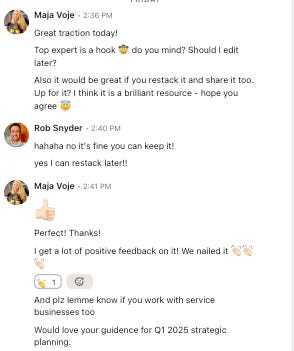 https://gtmstrategist.substack.com/p/can-you-get-to-your-first-million
https://gtmstrategist.substack.com/p/can-you-get-to-your-first-millionThe best advice I can give you is to think about value exchange, and trust me - I eat my dog food 🤠. In the last three months, I had the privilege to do a content exchange with three fantastic authors:
Aakash Gupta (131K Substack Product Growth)
 Product GrowthTactical Go-to-Market 101: How to Go From 0 to 1For product people, go-to-market can seem like a bit of a mystery…Read more3 months ago · 116 likes · 3 comments · Aakash Gupta and Maja Voje
Product GrowthTactical Go-to-Market 101: How to Go From 0 to 1For product people, go-to-market can seem like a bit of a mystery…Read more3 months ago · 116 likes · 3 comments · Aakash Gupta and Maja VojeRubén Domínguez Ibar (43K Substack The VC Corner)
 The VC CornerIs this the end of SaaS?🤔, Venture debt investments swell in Europe💰, Navigating Corporate Venture Capital💡Welcome to The VC Corner, your weekly dose of Venture Capital and Startups to keep you up and running! 🚀…Read more2 months ago · 22 likes · 1 comment · Ruben Dominguez Ibar
The VC CornerIs this the end of SaaS?🤔, Venture debt investments swell in Europe💰, Navigating Corporate Venture Capital💡Welcome to The VC Corner, your weekly dose of Venture Capital and Startups to keep you up and running! 🚀…Read more2 months ago · 22 likes · 1 comment · Ruben Dominguez IbarPaweł Huryn (76K Substack The Product Compass)
 The Product Compass5 GTM Principles You Should Know as a PMHey, Paweł here. Welcome to the free archived edition of The Product Compass…Read morea month ago · 75 likes · 9 comments · Maja Voje
The Product Compass5 GTM Principles You Should Know as a PMHey, Paweł here. Welcome to the free archived edition of The Product Compass…Read morea month ago · 75 likes · 9 comments · Maja VojeI learned so much from these excellent content creators. These collabs made me a better Substack writer.
I will forever be grateful for the support and good faith that Aakash, Rubén and Paweł have shown to my work. ❤️ I hope I can give back big time with interest one day.
OK - this mode was too long, but I wanted to thoroughly review it since I bet that 80% of the readers are at this stage.
Now, let’s serve the other 20%.
If you want to speed up your go-to-market journey, check out GTM Strategist - my book, checklist, and other resources that will help you get profitable traction much faster. They were battle-tested with over 6,500 entrepreneurs, and they work.
 Mode #2: Ad-Hoc viral launches with influencers
Mode #2: Ad-Hoc viral launches with influencers Head of Growth at Rows.com, Henrique Cruz, shared some secrets of the viral launch of AI Analyst✨ on X and LinkedIn. The campaign resulted in 30 million views on social media and more than 128,000 sign-ups in 7 days.
He reflected: “A big part of it was an accident. One we can’t take credit for.
Part of the launch plan involved sponsoring a handful of content creators on Twitter to share the announcement. As luck would have it, someone came up with the hook “AI just killed Excel”. This was not part of the brief nor something we would have written, but it took off online.
The hook was provocative enough that it got people interested, and the launch video was compelling enough to convince people to try the Rows. That started a cascading effect. More than one year later, we’re still seeing the ripple effects of that campaign.”
 One of the most viral tweets about Rows’ AI Analyst✨
One of the most viral tweets about Rows’ AI Analyst✨

Here is my mini-interview with Henrique:
 https://www.linkedin.com/in/henriquemcruz/
https://www.linkedin.com/in/henriquemcruz/Hey Henrique, thanks so much for doing this 🙏.
I have three questions:
How did you select influencers for this campaign?
Henrique: I spent a few hours on Twitter and LinkedIn (especially Twitter) following people who posted about AI news and AI products. After a few days I had a good sense of who were the content creators I thought would be a better fit, created a shortlist and sent them all DMs.
This was the content of the DM:

How many did you include, and what was the budget for the campaign?
Henrique: We sponsored 6 content creators across Twitter and LinkedIn, and spent $5k
How did you validate these collaborations as the Head of Growth at Rows.com?
Henrique: “We didn’t need to do a lot of validation after the collaboration because the results were obvious. In the first couple of hours, we started seeing dozens of content creators organically posting about the AI Analyst, ranking up millions of views, and 128,000 signups in the first 7 days after the launch.”
Henrique is a virality wizard 🧙♂️
You can dive deeper into his viral methods (from billboards to avatars and cards) in this article & do follow him on LinkedIn, he is one of the G.O.A.T. - a stellar practitioner who shares great content.
Once you have validated that influencers work for you through guerilla and ad hoc tactics, it is time to double down and build a system! Let’s get serious.
Mode #3: Influencers as a money-making machineOK - so it happened once and it felt like magic.
The next challenge is: can you make it repeatable, predictable, and scale it?
What makes a good influencer collab:
Right content-audience fit and influencer selection ✅
Great exclusive offer ✅
Creative promotion asset - not a billboard ✅
Multiple influencers engaged to create a snowball effect ✅
The average reported ROI is usually >400%.
A study by InfluencerHub found that companies that invest in B2B influencer marketing see a $5.20 return for every $1 invested.
If that were true, brands would pump all their marketing dollars into influencers instead of ads. But we all know this is not the case.
Cumulative data is BS and we need to understand them case-specific.
I asked my colleague Hector Forwood, who runs Flooencer, a business influencer marketplace, to share some better insights. And oh boy, did he deliver 🙌 - thanks a million. He shared some real campaign data and allowed it to be published ❤️ - huge Kudos, legend!
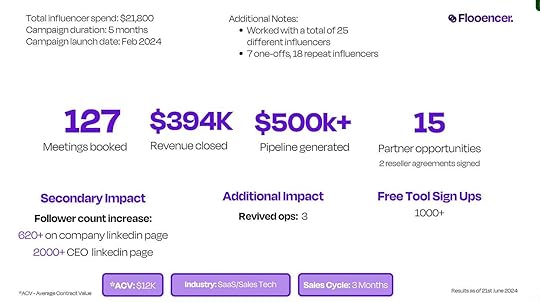
You can clearly see that there was an investment and time to value was longer than the campaign itself - not within a week because a complex software solution is not bought like a loaf of bread 🥖.
What is even more interesting to me is the next deep dive - results per influencer. You can see that they vary differently. It is not a one-shot opportunity - you hedge the risks by working with multiple influencers and double-down on what works well.

Now, how can you do this:
- DIY - scale your operations or hire an influencer manager/social media expert to join your time.
- DWY (done with you) - tools such as Flooencer, Favikon, and PartnerStack.
- DFY (done for you) - agency, experienced freelancer, or consultant.
What is the right choice?
If influencer relationships are mission-critical and you will do them a lot, it makes sense to do them in-house. If not so much or if you are still validating this channel, outsource. That would be my best logic.
I DIY this for my launches because I work on long-term relationships, but I have 20 meaningful relationships, not a CRM of 3000 influencers to manage. I’m happy to exchange more good practices.
Voilà!
Now, it is your turn to implement this!
What can you do in September to test if B2B influencers would make sense for you?
Pitch a selected influencer relevant to your audience?
Find 3-5 influencers to support your next launch?
Measure ROI and time-to-value of your collaborations?
You decide.
Congrats on finishing reading another GTM Strategist Substack 👏
If you liked this post, hit ❤️ on Substack so I will know that I should create more content like this for you.
If you have questions 💬, I reply to every single comment and email
Share this Substack with a team member or a friend who can benefit from it - just forward the email. 📧
If you want to support my work, head to https://gtmstrategist.com/ and purchase our solutions
Happy back to school! Buckle up for another value-packed Substack next week in which we will explore what GTM Engineering is and how to change your GTM ops into a well-oiled machine.
Make sure you are subscribed!
Till next time
Maja
August 23, 2024
Can you get to your first million with a single case study?
Dear GTM Strategist!
Are we overthinking GTM and wasting our precious resources and time by worrying about the next hot "hack"?

GTM should be a straightforward, proprietary strategy you and your team can quickly grasp and implement. It should be crystal clear to everyone and distinctive enough to catch your competition by surprise.
Here is a simple example:
I sold all consulting services in Q2 by showcasing a single case study. The case study described how my client made $4 million sales pipeline for a B2B SaaS solution by targeting large companies using outbound. The (not so) secret ingredients:
Differentiated positioning
Kick-ass sales deck
ICP-first landing page for the offer (not a home page!)
Well-targeted Outbound campaign with 300-400 relevant prospects focusing on a no-brainer offer
The service consisted of 4 workshops and co-creation of deliverables (contact bases, segmentation, outreach sequences, and refining the business development process) with a client.
Before I stumbled upon Rob Snyder's Harvard Innovation Labs: The Path to PMF presentation, I thought this success was a stroke of luck.
But it is actually a proven system that you can replicate.
I took 56 screenshots and studied his presentation for 6 hours (did all exercises).
I STRONGLY encourage you to dive deeper into it yourself
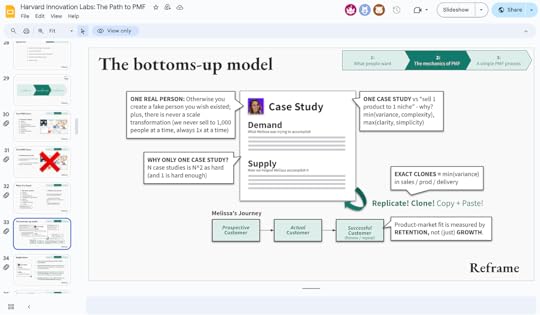 See the full presentation here
See the full presentation hereI've also distilled the most crucial lessons and action points to a shorter version and asked Rob to share more examples.
In this Substack, you will learn:
There is no such a thing as demand creation, according to Rob and a giant Poodle Silky 🐩 I met in Budapest
You will be invited to consider a bold idea that the true PMF is just ♻️ replicating a single case study made with a single person you can help in mind
Your most essential sales material can be a simple case study, not a 36-slide sales deck or an 87-page long white paper
Become more confident in communicating the results to clients and getting the right job done again and again for the client.
Let’s dive right in!
You cannot create demand. You can only find and harness it."I chuckled the first few times I heard the job title “Demand Generation Manager.” Most businesses can’t generate demand any more than they can generate the sun rising. Your aim is to tap into demand rather than trying to generate it. You want to be like a solar panel absorbing the sun’s rays and turning them into usable energy as efficiently as possible." - Allan Dib, 2x best selling author, The 1-Page Marketing Plan (2016) & Lean Marketing (2024)
Yu cannot convince people to buy your product. Instead, you should focus on identifying those who already have a need for it and are willing to pay for it.
Rob thinks of demand differently than most others. For him, demand is “supply-agnostic”. Don’t think of demand FOR your product. Instead, think of demand as: “What’s the project on someone’s Asana board that I can tie my product to?”
People are searching for solutions and jobs to be done, not products.
Meet Silky, a lovely poodle 🐩 parading in Budapest that our Australian Shepherd Juno enjoyed playing with.
He sports a continental groom, a classic style for poodles but not for other breeds.
Would I ever groom my dogs to look like Silky? - Nope.
Is it convenient for a dog guide to do it? - Nope.
Is Silky a great-looking doggo? - Juno approves. 🐾
 Silky (maybe Sirky)
Silky (maybe Sirky)But when I saw Silky for the very first time, I whispered to my husband:
“Oh boy, I would never cut Juno like this.”
No fashion trend or expert recommendation would ever make me consider replicating “Silky style” on an Australian Shepherd because it is impractical. She would probably get sunburned and too hot, and TBH, she would look like an overweight lion. 🦁
Silky’s owners and I are not the same ICP. For instance, Silky’s owners' job is to have a great-looking show dog, while my job is to have a well-trained (and tired) working dog.
Understanding these 'jobs to be done' is crucial for creating products and services that truly meet your customers' needs.
There is no market such as “all dog owners”. But among dog owners around the globe, there are niche markets for nearly anything. You just have to find your niche and serve it well.
 Please do not put this stat into your pitch deck.
Please do not put this stat into your pitch deck. Your job is to “find your people,” but Rob Snyder added a brilliant component to the mix:
*Selling* is the only way to figure this out *for real*
This doesn’t mean “saying that they will buy”, nor “clicking on some fake gateways on the website to learn that a non-existing product is out of stock”.
They have to pay for it, use it, and keep using it. Hopefully, you can even upsell them, too, so your businesses will grow together.
Back to Michael Skok’s definition of Product-Market fit, which includes securing willingness to pay.
Rob argues that what’s most important is the post-sale “hell yes” - which for B2B software startups often means renewals and upgrades, but for consultants, it often means testimonials and referrals.
In simple words: start selling as soon as possible.
But how?
Figure out your ONE replicable case study that has intense demand!Rob makes 3 arguments about case studies that are mind-bending.
First, he argues that the case study is *the* most upstream part of your business - it’s what defines your ICP, persona, market segment, differentiation, and everything else that matters. When you feel like a million things matter… you’re often focusing on the things that emerge based on the case study, not the case study itself. In this way, the case study model provides a powerful focusing device.
Second, he argues that a business is just a system that replicates case studies. It’s not more complicated than that. And you can look at all the things you do (marketing, sales, success, etc.) as components of the “case study replication factory” - and ask yourself, “where’s the factory bottleneck right now?” With this mental model, you always know exactly where to focus in your business.
Third, case Studies are your strongest sales and learning materials. Shockingly, just showing the case study to potential customers is a highly effective sales approach, which also helps you FIGURE OUT what case study you're delivering.
How to figure out your case study and find product-market fitStartups should talk to 5-10 potential customers every week to get enough volume to earn an intuition about what the real replicable case study should be. This helps avoid getting “pigeonholed” - and then, as you serve customers, you can see the patterns emerge across customer conversations.
All this is done on the path to product-market fit. Here are 5 levels of PMF:
 Harvard Innovation Labs: The Path to PMF
Harvard Innovation Labs: The Path to PMFThese levels represent different stages of product development and market acceptance, with the ultimate goal being to reach PMF Level 5, where your product is a perfect fit for the market and demand is high.
Case study: ParallelParallel is a growing startup that offers an AI-powered financial modeling tool. The market for such tools is competitive, with tons of options available for startups.
What Parallel found is that startup founders had often tried & failed to implement other financial modeling tools because those tools were meant for finance teams, not founders (who rarely come from a finance background). But founders felt like they needed ways to run hiring and fundraising scenarios, and wanted to be in the driver's seat for this vs. relying on an analyst or fractional CFO.
You can see their case study emerging based on this:
A founder looking towards hiring or fundraising, wanting to run scenarios and see cash implications.
This founder considers an excel DIY model, learning a financial-modeling-for-finance-people tool, or a finance assistant for founders (which is what Parallel offers).
A founder explores Parallel, and is quickly able to model scenarios and get confidence about when to raise, how much to raise, when to hire... and can keep iterating on their scenarios for every big & small decision that impacts burn and runway.
Parallel is uniquely suited to deliver a case study in an area of intense demand. They can focus on replicating this case study and getting every customer to say "hell yes" post-sale.
Why case studies workUnlike a typical problem-solution-result structure of a case study, Rob’s framework acknowledges more realities:
<5% of the market is ready to buy now (and you know that from your conversion rates). A prospect is not always in a position or willingness to buy. You must recognize buying/sales triggers and nail the best marketing timing.
Good positioning = a promise to a client + why you. We are competing against alternatives and should, therefore, be laser-focused on DIFFERENTIATED VALUE. Why is your solution a better fit for the client than alternatives that they are considering? A buying decision is never made in isolation. You compete against other options and “do nothing” about this.
Focus on results - clients do not buy how (input) but what (output). Simply put, they do not necessarily care how many hours of research/development you put into your product; they care about what results they will get from using it and how fast. Double down on the promise and provide evidence (case studies) that you will deliver on this promise for them. Never neglect the emotional and personal benefits attached to the promise. Not everything is rational. Remember Silky.
Again, talking to customers is crucial. You just can't know what will work in advance and from a whiteboard. You figure out all of this - the case study, the product, the segment, the "when" -- all through sales and delivery conversations. Why do people say "hell yes" pre-sale? Why do people say "hell yes" post-sale? What does that tell us about the case study?
After you find your winning formula, you can repurpose this case study for your sales deck, and you are ready to win some new business. Now, let’s book some meetings!
Do not overthink - start doing ASAP1 ICP +
1 Offer +
1 Channel
___________
1 million.
Learning by doing and staying focused is the answer to our Product-Market fit prayers, my friend. Distractions and FOMO tend to be the founder’s worst enemies. Here is how Rob describes the path to PMF:

You will likely get your first ten customers from your personal and second-degree network. If that is not available immediately, you can go on platforms where target customers are actively searching for solutions or send some personalized outbound.
How to book at least 5-10 relevant meetings a week:
LinkedIn + email is usually more than enough to get to 5-10 per week.
You can use automation tools (e.g., Sales Nav + Dripify; Apollo), but don’t sound like you’re using automation tools.
Get to 5-10 per week, then debug your case study, sales + delivery process and targeting
Eventually, your *scalable* pipeline source will emerge based on your case study
It does not hurt to publish your case study on social media, too, but it will take months to build a relevant audience if you have not intentionally done so before.
Later on your GTM journey, you will have to find 1-3 replicable growth motions and created processes so that they will repeatedly work well for you, but for now, your GTM Motion is:
Inbound → Have a decent social media presence and communicate results there.
Outbound → Build a list of 200ish ICP-like decision makers, present a case study, and invite them for a meeting.
Paid digital → Do not do it before you have validated your case study.
ABM → Start building relationships with 5-10 dream clients by value commenting on their posts.
Community → Create a value post about the case study in communities relevant to your ICP.
Partners → Do not do it before you have validated your case study.
Product-led growth → Sell a result of the case study. Do not code yet- show a prototype, do it manually or with some tweaked tools/automation to prove that you can deliver the desired result.
Action time!
Read through Rob’s epic presentation to get more insights and ideas.
Follow him for more PMF wisdom on Substack and LinkedIn.
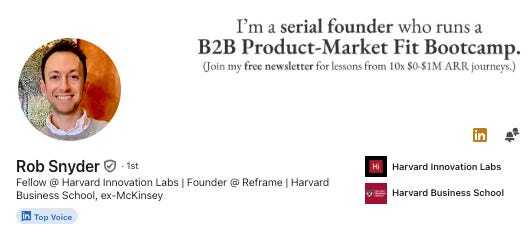
Work on your case study using this framework - I did it, and it is great.
No excuse.
Let’s go to market!
One case study at a time.
- Maja
If you are new here, check out GTM Strategist solutions, which will help you get profitable traction much faster. They were battle-tested with over 6,500 entrepreneurs, and they work.

August 16, 2024
How to find clients for your freelance/consulting business?
Dear GTM Strategist!
I retired.
 This is me floating in a thermal lake with fellow seniors, NOT thinking about business.
This is me floating in a thermal lake with fellow seniors, NOT thinking about business.Just kidding. This photo is from Heviz, the largest swimmable thermal lake in the world. The water is very warm - 35°C (95°F). More floating than swimming for us, experienced spa veterans.
After spending a couple of days in a thermal resort, my husband, two dogs and I are off to Budapest now.
As we are beating the heat wave, I wanted to share our “holiday chill” to answer a question that keeps on popping up from our community on LinkedIn: “How to get clients for freelance/consulting businesses?”
Short answer: They are probably already in your phone book.
Usually, it boils down to recommendations, outbound, and some inbound.
But since I know that you are serious readers who will not settle for that, here is my long answer:
Working as a solopreneur for the last 15 years taught me a thing or two about getting clients. Last year, when my partner Tim and I trained over 200 freelancers on scaling their service businesses, I truly systemized my thinking around the subject.
The results of our training:
85% of the class found their first client within 2-3 months of the program
2/3 of them doubled or even quadrupled their income
15 attendees are no longer solo but employ other people in their businesses now.
As we analyzed the class results, the holy trinity of how they got new clients was indeed recommendations, leads from their inbound (hack = value comments in communities) and actively reaching out to businesses that can benefit from their services.
I exited this business to have more bandwidth for the GTM Strategist. FOCUS.
But I take a lot of pride in this class because it was truly a life-changing project.
In this post, we will tackle:
Positioning - it’s where you can really make or break the deal when it comes to freelancing or one-person businesses
How to engineer a fair deal and construct an MVP collaboration model
5 ways in which solopreneurs can acquire new business based on my sample of working with over 200 freelancers
This post can also help business owners and leaders work better with freelancers. Everyone tells you how to be an “enlightened leader to your employees.” How about leading the freelancers?
Positioning: Are you just another “Freelance Copywriter”?Let’s break the solopreneur code!
Recently, I was recruiting for the role of digital marketer at my company Growth Lab.
Freelance, contract, employment - I really do not have preferences as long as I find the best person for the job.
A variety of candidates applied.
Copywriters, ghostwriters for famous entrepreneurs, e-commerce people, CRO specialists, camouflaged agencies - you name it.
How on Earth can I make a rational decision out of such a heterogeneous talent pool?
I had to take some mental shortcuts to narrow down the pool to something manageable.
Three things were a hard “no” for me:
Not giving a shit. I am sure 70% of applicants did not even bother to see what we do at Growth Lab. If you do not bother to check out my business, why should I bother to interview you?
Vanilla positioning. “I do copywriting for socials and blogs.” Well cool, so do I, but did you ever do Substack/LinkedIn editing? Do you have any references that are similar to what I am doing?
No evidence that what you do works. Sorry, but it is such a huge turn-off if you pitch me thought leadership ghostwriting services, and then I see that you post 2x a day and barely get 1 to 2 thumbs up on your posts. More minus points if your profile was last updated in 2009. You can easily bypass that by linking me to a portfolio of what you did for other clients. But you did not - so how can I know better?
For most freelancers, consultants, and solopreneurs, riches are in the niches.
You did something that worked well.
Now put this case to the megaphone and find 10 more businesses that could benefit from this.
You might also want to explore fields that are adjacent to your expertise.
If you excelled at copywriting for food supplements, I have high confidence that you can write direct responses for educational products.
Why?
If you can convince hundreds of thousands of people to eat blueberry powder in the morning to boost their brain capacity, you are likely to be successful in selling great digital products, too.
We will just have to tone down your strong direct response voice because we are dealing with a high-IQ, critical-thinking audience here.
But your powers of persuasion can be used for good.
Here is a visual that can help you grasp this.
 Beachhead strategy is all about obtaining concentrated references in niches before evolving to upscale segments.
Beachhead strategy is all about obtaining concentrated references in niches before evolving to upscale segments.The more specific you can get in: “I do X to help Y to achieve Z by doing …”, the more likely it is that your positioning is going to work well.
✍️ Your turn:
Write a list of your top 5-10 achievements (If you struggle with that ask your colleagues to help you with it. I love to ask them “How would you recommend me to your peers?” or “For what would you come to me instead of everyone else?”)
Reverse engineer the Ideal Customer Profile from these references - who can you help best? If you have challenges doing that - see this post.
Ask yourself where you can find these people—better yet, ask them how they search for service providers. I expect 60-70% will say through recommendations, so now you need to create a portfolio, some case studies/social media posts and before-during-after testimonials.
Have a decent presence on social media - at least a profile so that I do not end up on your TikTok when I search for you (unless you sell TikTok services). This post has useful materials on how to do that.
If you are still in the super-early stage of the business and cannot yet pinpoint what exactly you will do, just list down all the ideas, research what your ICP needs (their social media posts, job posts, industry trends) and run 20 interviews with them. Then do a pilot project - you can use references from your previous jobs or offer to work for free for the first month. You can even do a dummy project, like a concept for a non-existing or famous brand. Doing the work will provide more answers for you than research.
The Deal: I buy solutions to my problems, not hours of workWe need to agree on something that is called a PROMISE.
For example, I can promise that my materials will help you achieve product-market fit faster if you follow every step.
How will you believe that I am the right person to do the job for you?
I need to present you EVIDENCE.
Case studies, testimonials, numbers, recommendations by respected people in the industry, etc.
How likely am I to buy your 5 LinkedIn posts per week if we cannot even agree on the expected result? I buy output, not input. And forgive me, but I care less about how many hours you will work on a new landing page than how much is going to cost me overall and what improvements/results I can expect.
Now, let’s examine what is going on in the head of a decision-maker, your future client.
Most business owners are quite simple to understand.
We are interested in ROI against alternatives for our investments.
And we like speedy, reliable and successful service execution.
The Alex Hormozi formula perfectly captures how we perceive the value.
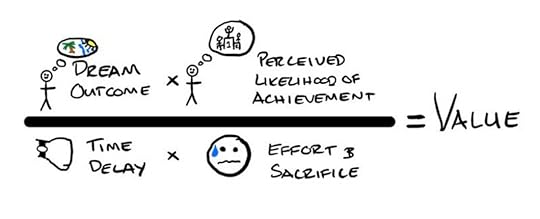 Consider this formula whenever you are writing offers - it is a game-changer
Consider this formula whenever you are writing offers - it is a game-changerThe closer you can get to this logic, the more likely you are going to make a sale.
Working with you is an investment for me.
This investment has opportunity costs.
Every investment has a different time-to-value.
If I work with a performance marketer, I want to see a clear ROI in 3 months, tops. But if I hired someone to make me a better public speaker, I will settle with my perception of improvement without solid numbers in the next 6 months or so because I understand that my progress here cannot be linear and easy to measure.
Here are the risks that pause my decision-making: I will spend my time on onboarding. You will have a learning curve, and we may not be a great fit, so the investment in our collaboration could even be a sunk cost for me. Worse, I can pre-pay you, and you do a shitty job or even ghost me.
I know there are horror stories from the other side, too: of business owners who are scamming freelancers, who belong more to the mental hospital than in business, and founders with delusional expectations that everyone should work as hard as they do and be as committed that will drain the life out of you. Just to name some.
We need to develop TRUST to work together.
I must trust you to be the right person for the job and that you will do it well.
You must trust me that I will keep my end of the deal—deliver everything on time and, of course, pay your invoice as agreed (or sooner).
In the beginning, my biggest risk is whether I am going to make the best choice by hiring you. I could be wasting my time and money.
Your biggest risk is whether you have chosen the right opportunity, whether you can rely on me to do my part of the job, and, most importantly, whether we can produce good results that will generate a new testimonial or a case study for you.
The only way how this is going to work out is if we achieve a consensus:
What can/should be done? What is the objective? It does not even have to be a target number. It can be a process improvement, an insight, or a satisfactory deliverable in due time.
How do I work? What resources (design, web, my time) can I commit to this project and what is my overall availability to engage in this?
How do you work? Walk me through the process of what it is like to work with you. Then, let’s discuss your expectations, hard no's, and communication preferences.
My job is to secure 5K/month investment for 3 months and core content that you can work with.
Build me a demand generation machine that will generate at least 30K in sales, so I will have a positive ROI on this. Deal or no deal?
If we agree on this, half of the job (aligning the expectations) is done.
✍️ Your turn:
Envision your business in numbers. There are 2 ways to make 10K a month (OK, there are more, but for the sake of example, bear with me): either you work with 2 clients who will pay you 5K each or 10 clients who will pay you 1K each. What is a better bet for you?
Choose your pricing - early pricing is more a lifestyle choice or even a set-your-foot-in-the-door deal to get first references. Think:
Do you create as much value as a full/part-time employee to the company? Well, their gross paycheck is one hell of a pricing anchor for you.
Will you create a positive ROI in business? If you are a leadership coach and a client invests 30K in working with you - will they have at least 2-3x investment in 6-12 months? Great. Can you provide the evidence (testimonial, data, case study, etc.) that this is true?
Would you - as a human - rather multitask between 10 clients, develop good SOPs (standard operating procedures) and bring in more help to service them effectively; or would you rather dive deep into cracking challenges for 2 clients that will pay you more? Both ways work well in practice, and the latter is more of a boutique service.
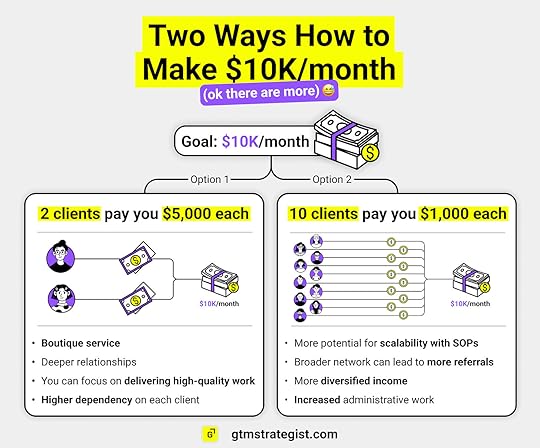 Each way has its advantages and its risks
Each way has its advantages and its risksWrite “Offer 1.0” that is all about the customer: what you will do for them, what the investment is, and how they can feel confident that you are the right person for the job. It does not have to be complicated - it can be an email. If you need some inspiration, check out this freelancer. This is such a no-brainer offer. Yes, I would hire Semir before a person who would write 3-5 posts a week for me. He reduced my perceived risks to the minimum.
 After reading this, all I need to check is if he understands my domain and if he misuses engagement pods. Worst-case scenario, the post will suck and I will claim a refund. But I have checked his profile before, and his posts do not suck, so the only question remaining is - can he capture my founder’s voice?
After reading this, all I need to check is if he understands my domain and if he misuses engagement pods. Worst-case scenario, the post will suck and I will claim a refund. But I have checked his profile before, and his posts do not suck, so the only question remaining is - can he capture my founder’s voice?Now you have a business hypothesis, a hypothesis to whom you will sell and what you will sell.
Time to make some bucks, my friend.
Show time: 3 proven ways to find clientsUnlike many social media gurus, I will NEVER tell you to spend 4 hours every day on LinkedIn value posting and commenting if your goal is to find 5 clients who will pay you a monthly retainer of 3-5K/month.
You can do it if you want, but if you are an experienced professional with real results, your time is better spent doing the actual work than writing inspo posts such as “What did you learn from staring at a bug in a hotel room as a tranquility exercise.” 🪲
What would work better?
In my network, 90%+ of service businesses use these channels:
Recommendations. People trust people. I get asked more than 20 times a week if I know “someone.” In reality, I only recommend up to 10 people that I have closely work with before. My credibility is at stake when I do recommendations. Make sure your entire relevant network knows about you launching your freelance business. Send them a text, DM, and email, and post about your service on social media so they can remember you the next time someone asks them for recommendations. But position well because out of all 52 graphic designers in their network, they only refer a handful - those know can get the job done and have relevant references. In most service industries, recommendations account for more than 50% of new business.
Inbound & Communities. Rule number one in GTM is to go where the audience is. If your audience is on LinkedIn, some Facebook, or Slack groups, go there and start value commenting and posting. Here is my detailed guide on how to do it. It takes a long time to build your own audience from scratch, but you might want to at least start building this habit for a get-go. Opinion leaderships start with having a point of view that is interesting and relevant to others. Very important is that you should see yourself as a teacher, not a seller. Every post and comment should deliver value and show the expertise of you and your business. You do not need to turn your business into a media company to get 5 clients. This post got me $30K in sales. It is a simple “lessons learned” with a screenshot. It took me <20min to write.
[image error] https://www.linkedin.com/posts/majavoje_leadgen-gotomarket-gtm-activity-7104717701884866560-mhkgIt was not even popular.
Outbound. Based on your ICP, develop a list of companies that you want to target and send them an email/LinkedIn message. People can shout that outbound is dead all they want, but if you have a well-targeted list of 200-300 decision-makers, a good relevant offer, and a real ability to help them, it can work like a charm and save you hundreds of hours in content creation. If you do not want to do cold outreach (people that you do not know), at least do some warm outreach and inform relevant ICPs in your network that you offer services now.
As your business matures, you will likely benefit greatly from partnerships and targeted ABM—Account-Based Marketing—but those things take time to develop. You can team up with other professionals, VCs, organizations, communities, or event organizers to present your case studies or proprietary methodologies and get leads from these placements. If you need new clients in less than a month, I give you my proven top three.
Think beyond channels.
✍️ Your turn:
This one is a no-brainer: Ask your previous clients, employers, and colleagues if they know someone who needs your services. If so, ask them for a warm introduction.
Figure out where your ICP actively collects information when they are making a buying decision in your problem space. There might be influencers, closed communities, events, or channels that they turn to.
If you are a beginner, check if what you offer is applicable to international marketplaces such as Upwork. Even if you are more experienced, job posts by your ICP will give you a good signal that someone is on the market actively investing in your fields of expertise.
If LinkedIn inbound is or could be part of your funnel, try documenting your journey by building in public. Not only can you help thousands of other people navigate their entrepreneurial path, but you can also win new business by doing it. This post got me 9 leads and 3 new clients. It was not one of my best-performing LinkedIn posts, but it is so good that others use it for their business development. Leads > Impressions.
Winning attitude: Easy to work withMy cousin David is a model and a TV host. He taught me a very important lesson:
“People hire me because I am easy to work with. There are so many divas, unreliable and unserious people that you stand out if you show up on time, take directions well, and act like a professional. Bonus points if you have a good sense of humor and some courtesy.”
Painfully true.
 This is my cousin David Urankar in a Gerry Frank photo. I think this was a commercial shoot in Vienna. No, we do not look alike 🤠
This is my cousin David Urankar in a Gerry Frank photo. I think this was a commercial shoot in Vienna. No, we do not look alike 🤠Lesson #1: just be the professional that you can be. Show up. Do the work. Respect promises.
Be an excellent communicator, a reliable person, and someone who fulfills the agreements.
Position yourself as “easy to work with.”
That doesn’t mean being a doormat. You still have hard limits, but you're flexible enough to meet my availability and capacity because I do not need another daunting process; I need a solution to my problems.
Be easy to work with.
You will have more fun and feel less stressed too.
I hope you liked this post and grasped a nugget or two that will help you grow your business or work better with freelancers.
Time is running out! Last 48 hours to claim your $20 discount on my “100-step GTM checklist” while I am on vacation - use the code SUMMER at checkout.
The checklist includes templates and workshops for:
Positioning
Pricing
Growth Ideation
LinkedIn system
…that can inspire you to create a new workshop or a service for your business. That would be one hell of ROI, right?

Good luck with your business.
Let’s go to market!
(stronger together♥️)
-Maja
August 9, 2024
Is having a 10X product good enough to win GTM?
Dear GTM Strategist!
Not so long ago, there was a founder with a great vision and super-shitty-scammy product who raised hundreds of millions … 🤠
Let’s get physical …
Famous founder Elisabeth Holmes raised more than US$700 million for Theranos. Their vision of "vast amounts of data from a few droplets of blood derived from the tip of a finger" could help billions of people—if the product worked.
And there is Ivan. He has 15 years of experience protecting government-grade secrets. He founded a company that provides world-class cybersecurity solutions for sensitive databases. Ivan prefers to speak about his product's features and technical robustness and shies away from using Ashley Madison-like taglines aka “Protect your secrets.” He is allergic to all that “marketing and sales fluff.”
Unfortunately, I know hundreds of Ivans with brilliant tech solutions who will probably run out of money because they do not “sell the story.”
If every big innovation needs some “hype,” does a “great story” matter as much as a “great product” in our age?
Even if you are a technical decision-maker, you have experienced the power of the Gartner visuals. You know - this bad boy. The technologies listed here are likely to attract more investors, early adopters, and media coverage:

Once we agree that telling a story is better than not telling it, we need an idea of what story to tell to create “hype”, “the momentum” for your product that will fuel your go-to-market journey.
Ultimately, we are setting up fundamentals for thought leadership, differentiation, and positioning.
OK, so you do X.
I should care because of Y?
Oh, and what is in it for me (Z)?
If you do this right, you will get much more free reach on social media, build a community of early adopters faster, get invited to speak at events and podcasts, attract free media/PR coverage, or simply make you and your team more excited to work with you.
My thesis here is that the winning story you will tell is deeply connected to your vision. In Carlos Eduardo Espinal’s Product-Market Fit Cycle model, the “big vision” inspires the journey to the product-market fit. Until recently, I did not pay much attention to “start with a big vision.” I assumed that it was the founder’s job to provide it, and then we, GTM people, and PMs get the job done. Looking back, this was linear, lazy thinking.

Here we bump into a practical problem:
Everyone told you that you need a strong vision …
… but no one told you how to get one.
In this Substack, I invite you to join me on a vision quest.
We will aim to answer the following questions:
What the vision even is?
How to become “more visionary”?
How do you create the “hype” that will fuel your GTM? I’ll share real examples.
What frameworks can you use to do this yourself?
Let’s keep our minds wide open and go on our first vision quest together!
What is a vision - and why should you care?A quick look into an online etymology dictionary reveals this:
vision (n.) - c. 1300, "something seen in the imagination or in the supernatural," from Anglo-French visioun, Old French vision "presence, sight; view, look, appearance; dream, supernatural sight" (12c.).
That is useful.
Let’s dive deeper into how to make it useful in business.
👁️ What do you see that others do not?
How do you foresee the future of your industry?
How will your product change customers' lives for the better?
What is broken in the current way that people are solving the problem?
Why are you a 10x or even 100x solution to your customer’s problem?
Is there an enabler (technology, legislation, social changes) that could drive innovation?
To every significant trend, there is an anti-trend. What is hot now? What is its opposite?
At first, vision is a dream of a future (outcome) that is better for the customer.
A bit of an “imagine the world where …” or “I had a dream” moment.
The product, therefore, could be seen as a bridge between imperfect reality and a “dream future outcome.” Let’s imagine a world in which AI would write this Substack so I could enjoy spending time in my garden.

And the hero of this story is not you.
Neither is your product.
It is your customer.
How well you tell this story plays a vital role in how successful you will be in “selling” this vision to your customers, investors, employees, partners, and other stakeholders.
In his book TRANSFORMED, Marty Cagan suggests: "Inspiring product vision is your single best tool for recruiting the people on your product teams." Damn right, as a small business owner, I cannot pay their market rate to advisors from established mega-companies such as Meta, Google, Miro, etc. The only way how they would consider working with me is if I can convince them of my vision. Brilliant people love building cool stuff with the potential to change the world—or at least industry.
This also has implications for fundraising—a vision is part of your pitch deck. It helps investors understand how much further you can go than the existing 15 customers who are paying you $1000 MRR. It also helps them estimate the market size for this opportunity.
Vision also gives you permission to say “yes or no” to an idea. I get like 12 ideas a week and filter them through the “is it coherent with my vision” lens. It keeps me away from crazy jumps to non-related areas in which I do not have a sizable audience or capacity to create a true vision. Product Strategy Canvas by Melissa Perri can help you bring your vision to a more applicable product and GTM level.
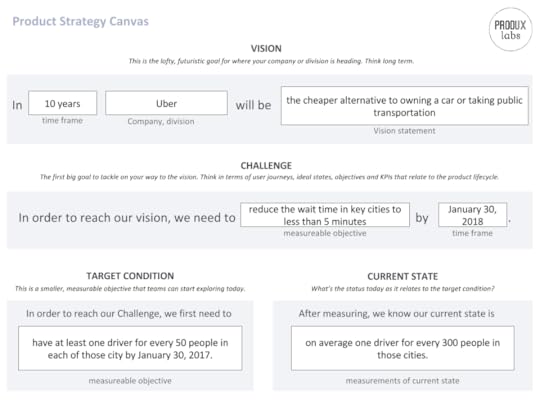 Source: Melissa Perri’s blog
Source: Melissa Perri’s blogLast but not least, your vision helps you win the hearts and minds of customers. They share your vision of the future you envision with them, your beliefs, values, and points of view. They will join you on your mission and support it with their purchases, recommendations, and brand love shared in communities.
But it is definitely not your customer’s job to tell you “the vision.”
You have to lead by it.
And that is easier said than done.
While I cannot give you a recipe for developing grand visions for your business, I can share some techniques that work well for me in my business.
Become more “visionary”“Think outside the box” and “imagine tomorrow’s problems” are great tips but pretty useless if you do not know how to do it.
How to be more “visionary”? What can you do to become or continue to be an original thinker who will create a strategic edge in business and mesmerize tens of thousands with the power of their vision?
I do not go to the desert and take psychedelics to come up with new products.
Neither do I sit around and wait around for magic epiphanies.

But I do have two secret weapons that create a strategic edge in my business:
Robust sparring with my team
Dialectic thinking
Let me be more specific by sharing an example:
Two weeks ago my team had a workshop with our advisor for AI products, Simon Belak (ex. Metabase, Zebra BI).
My initial “product vision” for building AI-first products for the GTM Strategist was to create a “chatbot” from all the materials I have produced so far.
I have produced more than 7,000 pages of text. It would be so easy to “build a GTM chatbot.” Just use OpenAI, build a new interface, and launch it as a new sub-product under the GTM Strategist brand, or use it as an acquisition tool.
Simon called this vision “narrow-minded and cynical.”
And he was right.
After a very challenging, intellectually exhausting, and sparring discussion with my team, we came up with a 100x solution, which, if validated, will be launched in Q4.
We had to think value-first and about what our customers really want—not what we could easily build. That is lazy thinking.
So, no—you will not get a “Maja bot 🤖” at our website to quote where certain models are in the book because that would be marginal added value at best.
But hey, if someone wants to build that, go ahead. I am happy to provide materials.
This approach is not for everyone. You need a really powerful sparring partner, robust communication practice with your team, and an environment of extreme psychological safety where being “right as a person” and “protecting egos” are subordinated to “choosing the best strategic bets for the business.”
It does not feel awesome to be called out as a leader in front of the team to “think small” - but it is needed to get the best out of the intellectual capacity of the group in our case.
What is more accessible to most is dialectic thinking, a really cool word that Bryan Zmijewski (ex. Stanford lecturer and IDEO) taught me. Dialectic thinking is the ability to view issues from multiple perspectives and to arrive at the most economical and reasonable reconciliation of seemingly contradictory information and postures. Bryan visualized dialectic thinking like this:

Social sciences struggle to evolve as fast as technology. To make this more applicable, let me give you my street-smart example of how I actively seek anti-ideas at unusual places of inspiration so that I nurture my differentiation and intellectual edge:
Read books and articles outside my core fields of expertise - philosophy, history, science. Fun fact, some of the best people working in technology did not study computer science.
Actively seek contrarian views; do not get trapped in your intellectual bubble (thanks, social media). I am exploring AI space, and I want to hear from anyone who believes that this is a doomsday for humanity since I believe that technology will benefit society.
Your opinions and beliefs should not be static. If you spin all the inputs to support your preexisting beliefs, you will learn very little. Often, I like to assume that I know nothing so I can learn the most.
“Real people have real problems”—best-in-class thinking does not have much tangible value if it is not tested against reality. Stay in frequent touch with your customers (do interviews, socialize with them, chat with them on social media, move and live with them if you have to)—keep it real.
Work within very diverse groups in terms of age, gender, background, and character. Great innovation is rarely born from a consensus in homogenous groups. Jess Schell, the CEO of Schell Games and the author of "The Art of Game Design" shared an inspiring stat about team intelligence. Diversity in a team (for example, having an equal number of men and women in a group) increases the overall intelligence of that group.
Treat your right brain hemisphere: visit galleries, read science fiction, enjoy concerts, and indulge in music for inspiration. Grasping the emotional side of “truth-seeking” and symbolism is as much, if not more important than following the scientific method when it comes to vision.
You will find your own ways to do it, but you will need to find time and space for it. As a founder with a service business background, I struggled for years to fully embrace the fact that strategic thinking is part of “my job” and that it cannot happen during 30-minute breaks between meetings. Reserve time for strategic thinking.
But do not let your inspiration go to waste or stay in your head. Use ideation, creative thinking, and design thinking processes to refine your ideas, prioritize them, and develop testable hypotheses. Most PMs and founders in my network swear by the Double Diamond framework to do this. You can dive deeper into this valuable Substack article by Paweł Huryn’s article on how to use the double diamond.
 Source: Design Council UKTransforming your vision to unique positioning to create differentiation
Source: Design Council UKTransforming your vision to unique positioning to create differentiation You already know that the best Go-to-Market strategy is proprietary. It is not a copy of what another company did or a template that you fill in with figments of your imagination. It is purposefully developed from your unique market and competitive insights. It plays on your strengths and counters the opponents’ weaknesses.
A vision plays a huge role in GTM strategy. It manifests across the elements of GTM, but where it can really make all the difference is in positioning. Positioning is crucial for determining the story that you will tell to create early traction—to build demand for your product or service.
In his best-selling book “Playing to Win” strategy superhuman Roger Martin taught us that a business can only compete on two things - lower costs or differentiation.
Most of us lack operational excellence to create economies of scale to compete on costs. Neither is very sustainable because competing on price is a race to the bottom, and there can ultimately only be one cheapest player on the market. This is why most of us will have to think hard to deliver value by differentiating ourselves.
The holy grail of differentiation is to be so ahead that you make the competition seem irrelevant in the eyes of your target customers. Like this:
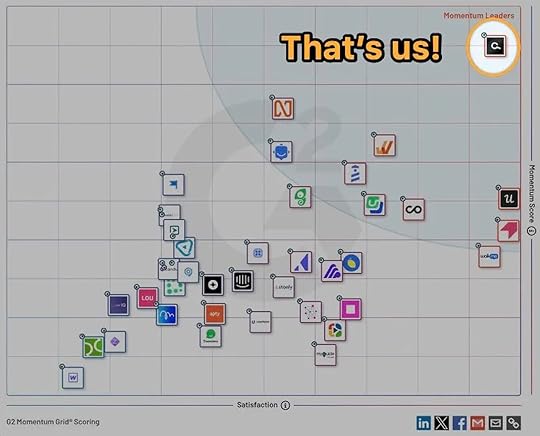 Source: Why you (probably) shouldn't create a new category by James Evans, co-founder and CEO of CommandBar via Kyle Poyar’s Substack Growth Unhinged
Source: Why you (probably) shouldn't create a new category by James Evans, co-founder and CEO of CommandBar via Kyle Poyar’s Substack Growth UnhingedThe right question to ask is not how you are better than your competitors. You should ask how you are different—radically different to really stand out. Ideally, you should create a class of your own where you are the only go-to solution.
And that is really hard to do if you are in a super competitive market unless you invent something new to “evangelize.”
What does positioning have to do with creating hype for your product?
Everything.
You need a compelling story, and you need to repeat it, repeat it, and broadcast it to as many target audience members as possible. They need to get to know you first, and later, you need to convince them to prefer you over competitive alternatives.
Great ideas are like viruses.
Seed them.
They will spread.
This is especially true among Early Adopters, who love to be “the first to grasp the future.” Your vision can be a huge magnet for them. They will even tolerate an imperfect (or even non-existent) product. They act as ambassadors.

Never underestimate the power of personal beliefs or emotional benefits that early adopters share with you. It is easier for me to get hyped about the idea of “open source self-hosted analytics software” because I am a sucker for data ownership and transparency and a bit of the cyberpunk here and there.
But if you want to get me excited about the 14th influencer management platform that I will get a cold email from this week, good luck. One exception: if I like you as a person, it is much more likely that we can work together, so do not be afraid to show your human side now and there.
It is all about “making me care” and “seeing what is in it for me.”
This is how we, early adopters, operate.
The story you will tell will determine if I am in or out.
But how to tell a compelling story?
Everyone keeps on talking about the hero's journey, strategic narratives, and visions of the future, but as a skeptical, pragmatic, and realistic thinker, I want my evidence. Okay, so you have a vision—how can I know that it is not some delirium but something that can actually be useful? Can you provide evidence that this works or could work not only for you but for other people, too? Again, positioning frameworks come to the rescue.
Questions to ask yourself:
Who is your ICP?
What are their problems (that you can actually solve)?
How are they solving these problems right now?
What sucks about that? :)
How is your solution different? (creates 10-100x value added)
How can you prove this is true? (evidence)
To answer these questions systematically, you are welcome to use Andrej Peršolja’s Positioning Framework:
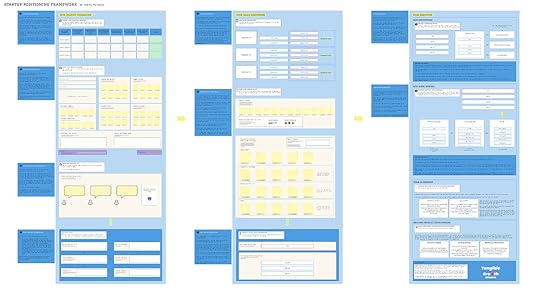 💥 Build your GTM hype … oops … demand generation machine powered by your vision!
💥 Build your GTM hype … oops … demand generation machine powered by your vision!More often than not in my career I was forced to take an “underdog” position. While competitors were pumping millions into their marketing and PR, I was in some basement with 2-5 other people (mainly engineers) scratching our heads about how to outsmart their media-buying machinery and get some eyeballs to our technically superior product that no one knew yet.
We will wrap up this Substack by analyzing a couple of examples of how to build a gentle vision into a powerful demand generation machine. Thought leadership will be our secret ingredient, and we will mainly use free channels.
Buckle up and onboard the hype machine!
#1 Big Secret: Redefine how trust is built in value networks
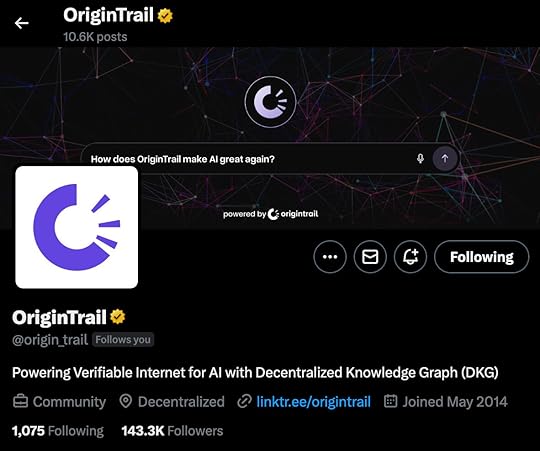
Challenge: I first experienced the power of this approach when I was the CMO at OriginTrail. I did not have the budget to buy five-digit event placements and super-inflated influencer media buys. But we had founders who brought an amazing vision to the space and were very eager to share it again and again. We also had real use cases and case studies to show that the technology worked, and we utilized partnerships to get more relevant exposure.
Result: In 3 months we created the audience that helped us raise $22.5 m of funding.

Tactics: At first, the growth was painfully slow. We had to do a lot of things that do not scale - local events, extra-niche podcasts, and magazines. We had to talk to anybody who would listen. Until we created a critical mass. The most important channels were Twitter (X), Telegram communities, B2B enterprise communities, and partnerships. We launched a Medium publication and started a newsletter. In a year, we did 56 speaking engagements, published 85 blog posts, and secured more than 140 media placements.
If you are like: “Maja - good for you, but that was six years ago - is that repeatable?”
Watch me strike again.
#2 Big secret: GTM is not rocket science. You can get profitable traction fast.

https://www.linkedin.com/in/majavoje/
Challenge: When I launched GTM Strategist last year, I was off social media for more than five months to focus on my product. I had no audience to launch to.
Result: In merely 3 months, I have built a 3000 people-strong waitlist for the book that got the best-seller badge on the week of launching it with zero media buy budget.
Tactics: I consistently provided and shared value and talked to my community members to create better content for them. This was done through LinkedIn organic posts, some relevant podcast appearances, partnerships with industry thought leaders, and lots and lots of content creation.
Again, I can give you concrete numbers: 180+ LinkedIn posts (2x a day during the launch + niche influencer posts), 12 podcasts, and 7 events.
Oh, cool—does it work for others?
You guessed it!
#3 Big secret: “Vendor reported attribution is BS” + Dark Socials

Chris Walker, Refine Labs
Challenge: Agencies are really hard to differentiate. Once I asked a dev agency founder “How are you different?” and he answered: “All our team members have worked on the product before” - yeah, that is you and 10,000 other vendors. Give me something more to work with here so I can refer you. But Chris Walker did a stellar job in differentiating a service business. He genuinely leaned on some truths and pain points that were kind of known to all of us who are working in the industry, but he said them in a really really compelling way. Instead of saying: “The attribution you get from your vendor is utter crap - ask your customers where they are coming from to get real data,” he used the phrase “self-reported distribution” and implemented it as an open-ended question, as you can see on Refine Labs website.

Result: Scales a service company to an estimated $20M+ per year. For most service entrepreneurs, it is really hard to scale beyond $5-10M due to the diminishing returns of adding people to the process.
Tactics: Podcast, live community events, repurposing videos on social media, events and guest speaking opportunities, and content marketing on their blog, LinkedIn, and YouTube.
Let’s hop to SaaS businesses next …
#4 Big secret: One channel + clear POV + consistency

Yulia Olennikova, N.Rich
Challenge: Having to compete with huge brands backed up by hundreds of millions of investments to win in the crowded ABM tech space.
Result: N.Rich started developing LinkedIn as a channel systematically in early 2023. Now they have about 30% of their pipeline influenced or directly sourced by paid and organic LinkedIn, cumulative following of their employees is >70k. They closed several deals with ACV of up to $120k sourced directly through their LinkedIn posts, and this is hands down the channel with the best ROI.
Tactics: Regular content sharing (POVs, case studies, frameworks, graphics) on behalf of the company page and employees’ pages. Social selling challenges - the most active employees get rewarded.
Last but not least, let’s do it by now putting a person to the front.
#5 Big secret: Personalized in-app experiences convert MUCH better

Emilia Korczynska, Userpilot
Challenge: Educate the market on the importance of personalized in-app experiences and data-driven decision-making.
Result: Through consistent education and valuable content, 90% of their traffic now comes from content, driving significant market awareness and engagement.
Tactics: Blog content, webinars, collaborations, events/conferences, LinkedIn posts, and product benchmark reports to continuously educate the market. Tease: See Emilia in action at Userpilot’s upcoming Product Drive conference, where she’ll talk about “SaaS product Metrics Benchmarks report 2024 - how to measure & improve key product metrics without code” (register for FREE: https://summit.productdrive.io/)
Do not be afraid to lead with your vision.
It can make all the difference.
Now we bump into another tactical problem - how to communicate your vision to other stakeholders. One of the teams that I work with secretly complained:
“The founder wants us to do thought leadership posts, but we do not know what to write. It is all in his head and whenever we do try to write something, he calls it basic and as it was not written by me”.
I like to use the Strategic Narrative framework by demand generation expert Ognjen Bošković, which is very comprehensive and is part of my 100-Step Go-To-Market Checklist. But even if you simply do the positioning exercises from this Substack, your marketers will have plenty to work with.
Chris Tottman who is a partner and investor at a VC company Notion Capital (check them up if you are from Europe) asked me this:
“You know that US start-ups have 7x more people in product marketing than European startups & the people good at "product marketing in Europe" - do you know where to find them?”
I did not know what to answer - the world needs more great Product Marketers to bring our “visions” to life and help really good products get the brand love and traction they deserve. So if you know where they hang out, let me know in the comments so Chris and I can know where to search for them next.
If you are like my advisor Simon🤠, you will do something like this for your new “visionary product”, commit to building a demand generation engine and get shit done! He made me fill in this template and is now guilt-tripping me on WhatsApp about how we are progressing. Gotta love Simon.

Once you are excited about your product vision, it is time to make it happen. To help you get to market quicker and more efficiently, I created the 100-Step Go-To-Market Checklist. Hundreds of businesses that I work with have benefited from the assets from this checklist. I’m taking a vacation next week, so to celebrate, the checklist is now available with a $20 discount. Use the code SUMMER at checkout!
The code is valid until August 19th, when I am back on track.
Writing such well-researched posts takes me 20-30 hours. I love doing it because I learn a lot by bouncing ideas with world-class thinkers.
Collaborators and accountability partners for this Substack post:
Ebrahim Karimi, Senior Product Manager who made me rethink the entire structure and cut out 8 pages of text to make this Substack better + shared some really cool sources with me
Chris Tottman, Partner at Notion Capital and best-selling author of another awesome GTM book: The Go To Market Handbook for B2b Saas Leaders: How to Stack The Odds in Your Favour when Scaling Your Software Business for inspiring me to write this post in our discussion about divergent thinking and for reviewing the early draft. We will definitely collaborate soon.
Paweł Huryn for having a framework for anything I can possibly think of on his Substack The Product Compass.
Inspiration sources not quoted in the main text:
Espinal, C.E. (2013). The Product Market Fit Cycle https://seedcamp.com/resources/the-product-market-fit-cycle/
Fisher, M. (2009). Capitalism Realism - Is there no alternative https://www.amazon.com/Capitalist-Realism-There-No-Alternative/dp/1846943175
Lafley, A.G. & Martin, R. L. (2014). Playing to Win https://hbr.org/books/playing-to-win
Cagan, M. (2024). Transformed: Moving to the Product Operating Model https://www.amazon.com/Transformed-Becoming-Product-Driven-Company-Silicon/dp/1119697336.
Rachitsky, L. (2024). Pattern Breakers: How to find a breakthrough startup idea | Mike Maples, Jr. (Founding Partner at Floodgate, ex-Product at Silicon Graphics)
If you have other valuable resources that can add value to this discussion, please link in the comments. Thank you for reading this post. I hope it will help you grow.
Let’s go to market!
Maja



